Lion Biographies
This page holds names and photos of fellow Lions who have submitted their biographies so that they
may be shared. Other biographies are also found on the Remember page for those who have passed away.
Honourary Colonel R.G. (Bob) Middlemiss, W/C(R) DFC CD
Commanding Officer, 427 Strike/Attack Squadron, 1962-1968
MILITARY SERVICE September 1940 TO June 1969
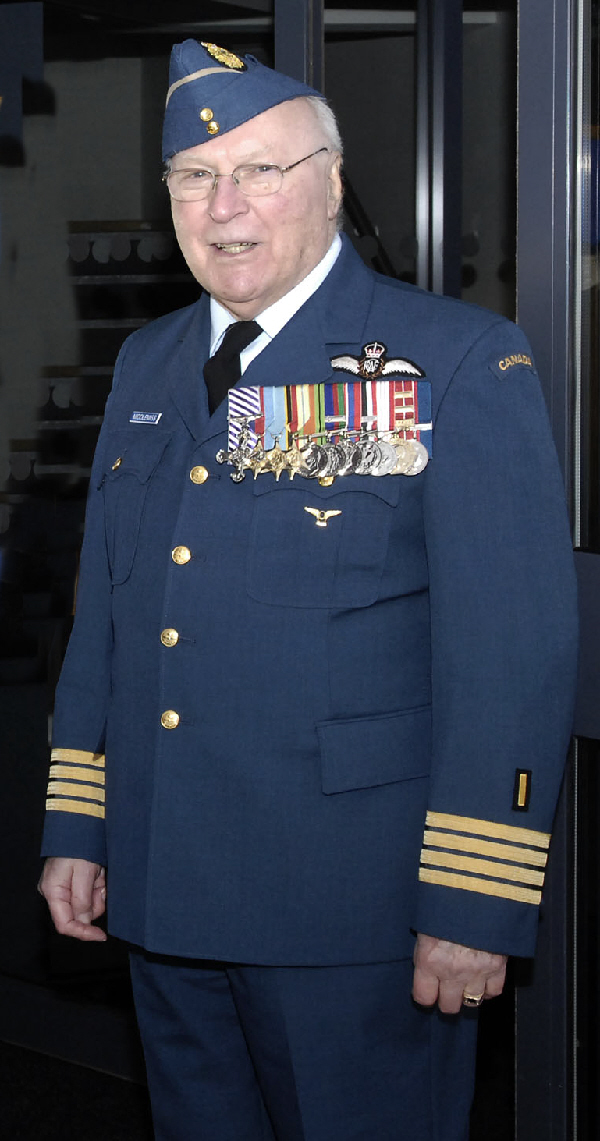
Bob was born in Montreal in October 1920a and was initially educated there. After graduating from high school he accepted a track scholarship from an American College but war broke out and he volunteered to join the RCAF. He was told when an opening was available he would be called. In the interim, his Dad`s Regiment, of which he was the RQSM, the 17th Duke of York`s Royal Canadian Hussars was mobilized as the 3rd Canadian Motorcycle Regiment. Bob decided to join as a trooper but was called by the Air Force and a few months later joined the RCAF on September 14, 1940.
He received his flying training at 13 EFTS, St. Eugene, ON and 9 SFTS, Summerside, PEI where he received his wings. He was posted overseas and trained on Spitfires at 57 OTU, Hawarden, Cheshire. He was posted to 145 Squadron and then later to 41 Squadron. They carried out operations consisting of air defence patrols against high level and low level fighter bomber attacks, convoy patrols in the English Channel, fighter sweeps, bomber escort and low level rhubarbs.
In June 1942, he was selected to serve with a team of Spitfire pilots posted to Malta. They were taken to within 700 miles of Malta on the aircraft carrier HMS Eagle and then launched to hopefully make the Island. During his tour with 249 Squadron on Malta Bob shot down and destroyed three enemy aircraft and damaged two others( ed. note: years later he found out out that one of the two damaged had been confirmed destroyed ) before he was shot down and wounded.
After recuperating, he served as an Instructor at 52 OTU and then 53 OTU in England. From the OTU he was posted to 403 Squadron, part of the 127 Wing commanded by Johnnie Johnson, the highest scoring ace of WW11. Bob had the honour of flying as his number 2 on a number of sorties. After completing two tours of operations he returned to Canada and Instructed on Hurricanes and Mosquitos.
Colonel Middlemiss was decorated for his war effort with the Distinguished Flying Cross the citation read as follows:
``This officer completed two tours of operational duty and has completed sorties from Malta and the United Kingdom. He has destroyed three enemy aircraft and damaged others. His standard of leadership as a section leader and flight commander has always been high and he has invariably shown outstanding courage``
Post war he was the first Exchange Officer at the RAF Central Fighter Establishment, flying Spitfire XIVs, Vampire and Meteor aircraft. He returned to Canada and was selected as the first CO of 421 Squadron based at St.Hubert flying F-86 aircraft. After completing Leapfrog 2 and delivering his squadron to 2 Wing,Grostenguin, France, he was tasked to form No. 1 Overseas Ferry Unit which ferried some 650 Sabre and T-33 aircraft across the Atlantic. Bob led units on 16 crossings.
His next move was to Air Force HQ as the Operational Project Officer for the replacement of the Sabre. Along with Jack Woodman, they proceeded to California to evaluate the top two contenders, the Lockheed F-104 and the Grumman F-11F-1F at Edwards AFB. As a result of their recommendations the Government selected the F-104. After HQ he was given command of the first CF104 Squadron, 427 Strike/Attack Squadron based at Zweibrucken, Germany.
Tragedy struck for him in Europe. While he was returning from leave in England with his family in a Bristol Freighter, the aircraft crashed short of the runway at 1 Wing, Marville , France killing his wife and all others in the aircraft with the exception of a crewman, his daughter and himself.
After recovering from his injuries, he was given command of 6 Strike Reconnaissance Unit, Cold Lake and returned to flying 104`s. Two years later he suffered a mild heart attack and lost his aircrew medical category. He completed his career at NORAD HQ, Colorado Springs and retired in June 1969.
In October 2003 he was appointed Honorary Colonel 427 Tactical Helicopter Squadron.
Decorations, Campaign Stars and Medals
Distinguished Flying
Cross
1939-1945 Star Aircrew Europe Star
Africa Star Defence Medal
Canadian
Volunteer Medal War medal 1939 1945
Special Service medal with NATO Bar
Canadian Centennial Medal (1967)
Canadian Forces Decoration and Clasp
Malta
George Cross Fiftieth Anniversary Medal
In civilian life Bob has filled a number of positions from VP Administration to Consultant for the Ontario Government to Chairman of the Industrial Training Branch at George Brown College in Toronto. Bob`s interests include Air Force History, attending Air Force Reunions, golf and working on his computer.
He has three children; Dan who is a Professor at Dalhousie University, Nova Scotia, Dale a daughter who is retired and lives in Barrie and youngest son Rob who is a Master Seaman in the Canadian forces, stationed in Colorado Springs, USA.
ed note:See the first of the Middlemiss videos. There are a total of five. Unfortunately the videos were taken in comfortable chairs and initially a quiet(we thought) environment. After two minutes there is considerable background noise.
W/C (R) R.G.(Bob) Middlemiss on Remberance
More on Bob Middlemeas
Bob Middlemiss DFC - 1939-1968, CO 427 1962-1965, Honorary Colonel 2003 - 2013
Commanding Officer, 427 Special Operations Squadron, 2010 -2012
Lieutenant-Colonel J.J. Alexander CD
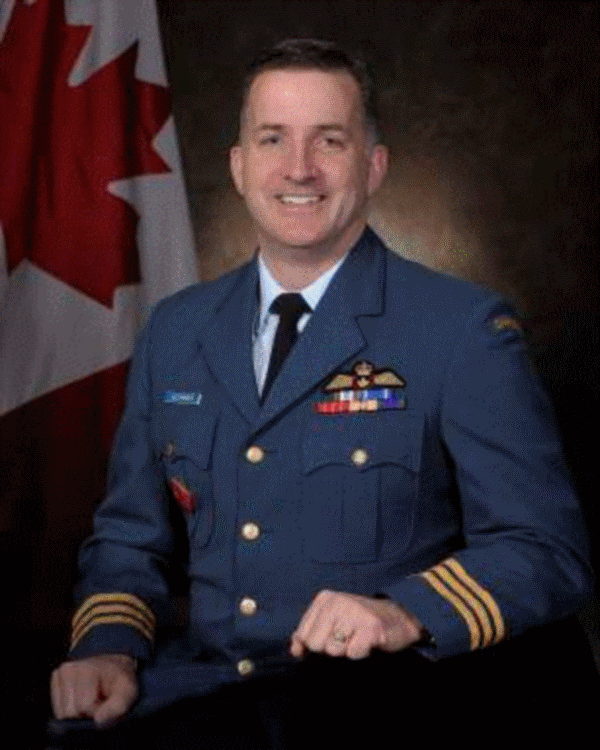
Lieutenant-Colonel John Alexander enrolled in the Canadian Forces in 1989. Upon completion of pilot training, he joined 450 Tactical Helicopter Squadron flying the CH-135 Twin Huey. While at 450 THS, he proudly served as the Squadron's only Standard bearer, having received the Standard from Governor General Hnatyshyn in June 1994. Upon disbandment of 450 THS in 1996, he was posted to 427 Tactical Helicopter Squadron, flying the CH-135 and CH-146 Griffon. He was subsequently posted in 1998 to Joint Task Force Two as the Aviation Liaison Officer. In 2001, he was posted on exchange to 33 Squadron Royal Air Force, flying the Puma HC1 helicopter, where he conducted operations in Bosnia (2002-3), the War in Iraq (2003-5) and Northern Ireland (2004).
In July 2005, Lieutenant-Colonel Alexander was posted to 403 Helicopter Operational Training Squadron as the Deputy Commanding Officer. In 2008, he was selected for the Joint Command Staff Program in Toronto. Upon completion of this program, he was posted to Canadian Special Operations Forces Command in Ottawa as the Headquarters' Commanding Officer.
Lieutenant-Colonel Alexander graduated from the University of Western Ontario (1989) with a Bachelor of Arts. He is also a graduate of the Royal Military College's Master of Defence Studies program (2009).
He is married to Tamra and together they have two sons, Joshua and Kiernan. An avid woodworker, Lieutenant-Colonel Alexander is also involved in the Scouts Canada program and coaching kid's hockey.
LCol Alexander took command of 427 Special Operations Aviation Squadron in August 2010.
Lieutenant-Colonel(R) Rick Barker CD, 427 Squadron, 1975-1978
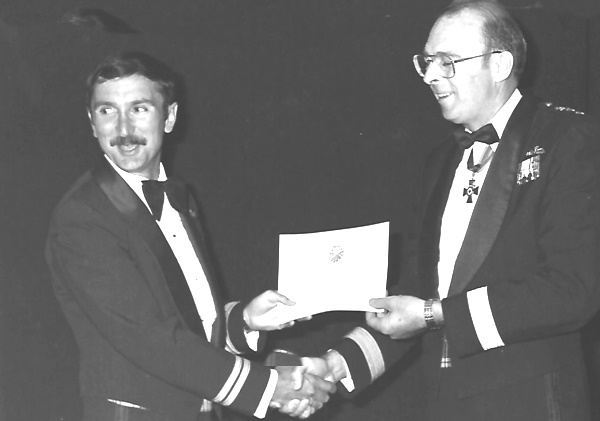
With a lifelong history in aviation, Rick Barker joined the CF in 1973, earned his wings in 1975 and joined 427 Sqn in September, 1975, as a Twin Huey pilot. He eventually retired after 36 years of service.
At 427 Sqn, he served in Ops Atlas Express (1976) and Arctic Express (1978) as part of the Allied Mobile Force (Land) based in Bardufoss, Norway. On three occasions, he worked in the Canadian Arctic: in Resolute Bay supporting Defence Research and Development (Pacific); on Baffin Island in 1977 supporting the Mapping and charting Establishment; and at CFS Alert helping to establish long-haul UHF links to that station. He accumulated over 1000 hours of flying time.
Following the year-long French course in Ottawa, in 1979 he moved to Uplands to become a Chinook pilot with 450 Sqn. In that time, he spent three years as Maintenance Test Pilot and his last year as Operations Office. As one of the few French-speaking pilots, he had the pleasure of supporting winter exercises in both Petawawa and Valcartier. The initial Rendezvous exercise was in 1981 and he participated in it and its successor, RV83 in Wainwright. His Chinook time exceeded 1000 hours.
After one year on the Aerospace Systems Course, Rick was posted to Rockliffe as the CF’s Cockpit Design Authority and soon the Project Manager of Aircrew Night Vision Goggles, renewing his link with 10 TAG. He influenced the configuration of all of the CF’s cockpits, including the new DASH-8 and Challenger.
Promoted to Major, he moved to the newly created CF School of Aerospace Studies as Senior Instructor, with personal instructional duties in Human Factors, Aircraft Instruments and Project Management.
Rick moved to Ottawa and the Directorate of Individual Training in 1990, initially responsible for air projects but eventually for Army and Navy projects as well.
From 1993-96, he served as Staff Officer to the DCDS and then moved to Colorado Springs to serve in the Missile Warning Center and a variety of staff jobs, including one building the operational procedures for ballistic missile defence.
His final assignment was back in Ottawa to the Directorate of NBC Defence which evolved into the Directorate of Chemical, Biological, Radiological and Nuclear Defence of which he was named Director. The values of the 19 projects in this directorate totalled $500 million.
Rick is retired in the west end of Ottawa with his wife, Libbie. Their son and his four daughters live in Denver while his daughter and her husband live in London, UK and work for NGOs.
Executive Editor-in-Chief/Publisher Airforce|ROAR Editor 2014-2018 Lieutenant-Colonel (R) Dean C.Black CD
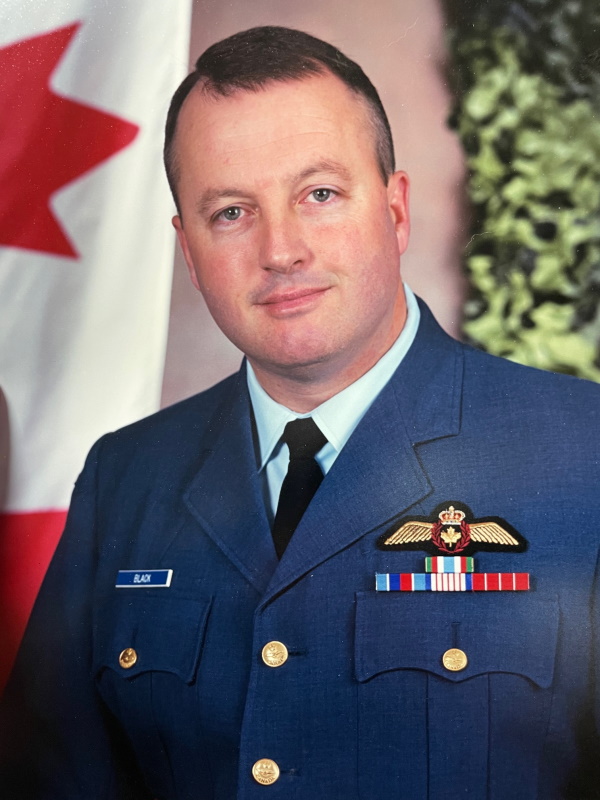
Dean Black joined 427 Squadron in November 1982 as a Lieutenant. He qualified as an operational Kiowa pilot in 1983, and began his flying duties with 427 Squadron in April of that year. He was promoted in May 1984 and was soon thereafter appointed Adjutant, under the command of Lieutenant-Colonel Ed Gosden, CD. In November 1984 Dean participated in the first of many "Gathering of the Lions". So enamoured with the group that he decided to put all of the squadron photographs together. Dean and his wife Cathy spent two years compiling the squadron history albums in their basement. He joined fellow woodworkers on Base and the albums were constructed. With the assistance of Al d'Eon, Dean traveled to Toronto to visit with the MGM/United Artists Canada representative, and secured a cheque for $1,500 to help fund the project. The most expensive item purchased were the plastic sleeves protecting the pages of the photo albums. By the fall of 1986 the history albums were complete (five of them) and they were transported to the Royal York Hotel, along with a great deal of other paraphernalia, for the Allied Air Forces Reunion. The 427 display outclassed all other squadron efforts.
Dean stayed in touch with many of the 427 veterans who made the annual trek to the squadron each November. He was posted to 403 Squadron in 1987, but eventually returned to 427 Squadron as a Major in 1997.
Dean was working as a defence analyst in National Defence Headquarters in the fall of 2005, when he traveled to London, UK to attend a conference. While he was there he learned that Dudley Burnside had passed away, and the funeral would take place while Dean was in London. Dean linked up with Lieutenant-Colonel Chris Coates, and Wing Commander Bob Middlemiss, Colonel Dan Edgar and Captain Steve Riff, to help represent the squadron at the funeral of the squadron's beloved wartime commanding officer.
He recalls with very fond memories many late nights at the Petawawa officers mess with Al d'Eon, Vern White, Stan Millar, Jim Moffatt, Weldy Moffatt, and many others¦
Squadron Chief Warrant Officer
427 Special Operations Squadron - 2008-2010
SCWO E.J.(Joe) Burns
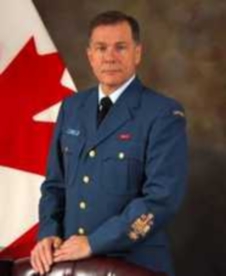
SCWO E.J. Burns was born in Bathurst, New Brunswick. In 1979 at Sydney N.S. he joined the Canadian Forces as an Air Frame Technician. Pte Burns was posted to BAMEO, Shearwater, Nova Scotia, after he completed his QL3 training in Borden, later that same year. He worked on the CH124 Sea King, until he was transferred to 880 Squadron where he worked on the CP 121 Tracker, with a short stint in VU 32 working on the CT 133 and CH135 Twin Huey.
When 880 Squadron moved to CFB Summerside, PEI, in 1981, Pte Burns followed until his return posting to HT 406 Squadron Shearwater in 1986 as a MCpl to teach Airframe and Aero engine systems on the Tracker. After four years in the school he was promoted to Sergeant and posted to 447 Squadron in CFB Edmonton in 1990. Unfortunately the Chinook helicopter was retired from service in 1991 and Sgt Burns was posted to the BAMEO organization working on the Hercules aircraft. When CFB Edmonton was closed in 1994 a posting to CFB Winnipeg was the next location, which would be the longest in his career. This tenure included numerous overseas detachments and included OP Relief in Nairobi, Kenya. In 2000, Sgt Burns was promoted to WO and remained in 435 Squadron until his promotion to MWO in 2004 when he began his second language training.
In 2005 MWO Burns was posted to DTAES in Ottawa, ON prior to being chosen to be a Career Manager for the AVN Cpl / Pte for his first two years then for AVN Sgt and Non Destructive Testing Trade for Cpl - MWO for his last. Recently promoted to CWO he requested his posting to 427 Squadron. An accomplished runner with seven marathons in eight years, he won the CF National Master Division in 2007. He can also find time to enjoy a game of golf when the opportunity presents itself.
ed: Joe is now (2012) Wing Chief Warrant Officer(Adjudant-chef de l'Escadre) at 9 Wing Gander(9 Ere Gander)
Major (R) Bruce Carnegie,427 Squadron service - 1987 to 1991
Military Service 1983 to 2011

While attending the University of Victoria, Major (R) Bruce Carnegie enrolled in the Canadian Forces in 1983 under the Reserve Entry Scheme Officer's (RESO) program as an Artillery Officer. In 1985, he transferred to the regular component of the CF and began flight training as a pilot. After earning his wings in 1987, he was posted to 427 Squadron (Sqn) as a CH-136 Kiowa pilot.
In 1990, along with the majority of the Light Observation Helicopter (LOH) Flight, he was seconded to 89 Rotary Wing Aviation Unit (RWAU) of the United Nations and deployed to Honduras on a six month tour of duty to monitor the demobilization of the Contra War. After returning from his U.N. tour, he remained at 427 Squadron as the Sqn Adjutant and Standards Pilot until 1991. He was then posted to 2CFFTS Moose Jaw where he spent three years as a Flight Instructor and two years as the Executive Assistant to the Wing Commander. In 1996, he was posted to 415 Sqn in Greenwood, NS, to fly the CP-140 Aurora and achieved an appointment to the position of Maritime Patrol Crew Commander.
In 2000, he was promoted to the rank of Major and was posted to 404 Sqn to teach others how to fly the Aurora, and held the positions of Flight Commander and Deputy Commanding Officer. In 2003, he was posted to 407 Sqn in Comox, BC, where he was employed as the Operations Officer and Chief Standards pilot. In 2006, he was posted back to Greenwood as the Commanding Officer of the Maritime Patrol Standards and Evaluation Team. Later in that year, after 8,000 hours of flying and 21 years of Regular Force service, he retired and joined Air Canada.
However, realizing he was not quite done with military life, in 2007 he enrolled in the Air Force Reserves and flew the CH-146 Griffon helicopter at 400 Sqn in Borden before finally retiring for good in 2011.
He is currently an Airbus 320 Captain based in Vancouver, BC, and has been married to his wife Cathy for 35+ years.
Bruce has also written a book about his flying experiences while deployed in Honduras and Nicaragua. It is called "Loach Pilot" and a book review by Col. Chris Shelly is here.
Major-General(R) J. Robert Chisholm CMM CD
MGen Chisholm left home in Sackville, N.B. in 1953 to attend College Militaire Royale. He finished there in 1956 and began flying training. His career in the Air Force began in 1957 when he joined 432 Squadron in Bagotville, Quebec and served there for six years flying the CF-100 and as Station Flight Safety Officer. A three year exchange tour with 111 Squadron of the Royal Air Force followed during which he flew the Lightning All-Weather fighter. In 1966 he was promoted to Squadron Leader and appointed Senior Staff Officer Flight Safety at Air Defence Command Headquarters. Following Staff College in 1970 he was posted to 427 Tactical Helicopter Squadron. He trained with 403 Squadron in Petawawa in the fall and completed training on the Twin Hueys in January, 1971. He then moved to 427 Squadron which at that time did not any Hueys. This period was shortly after the beginning of the military unification, and the squadron was in the Army environment. The members of the squadron, particularly the officers, were Army, Navy, and Air Force. At that time he was a Major but there were other officers who were more senior than he was. In May of that year, 403 Squadron received some new CUH-1N Hueys and further training was required. In June, 427 Squadron also received the Hueys and BGen Chisholm flew with them until October. His most interesting flight with the squadron was going to Texas to fly one of our new Kiowas back to 427.
In less than a year MGen Chisholm was assigned to 403 Squadron in Petawawa as DCO, since the Deputy Commanding Officer was sent to another job. It was a training unit which provided a new experience for him. Two months later the Commanding Officer was unexpectedly taken away from 427 Squadron, and Bob as a Major became the Acting CO. During the summer of 1972 he moved the squadron to Gagetown, N.B. and it became an operational training unit with a new CO, Lieutenant Colonel Wright. LCol Wright had been the DCO whom Bob had replaced and he also had Army helicopter unit experience. MGen Chisholm was posted back to 403 Squadron. A year later LCol Wright was sent to Germany and Bob was promoted to Lieutenant-Colonel and assumed command of the unit. It was an excellent squadron and after 3 years he was sent to NDHQ in Ottawa. In 1976 he was promoted to Colonel and assumed the position of Director of the Directorate of Flight Safety.
After NDHQ he became the Base Commander in Comox, B.C., and then in 1972 he was posted to St. Hubert, P.Q. to be the DCOMD of 10 Tactical Air Group which controlled all army helicopter squadrons in Canada. A year later he was promoted to Brigadier General and became Commander of 10 TAG for three years. He had spent eleven years in the army tactical helicopter world and had the opportunity to work with many officers and non-commissioned members. It was a very professional organization and he was proud to have been involved with them. Another positive aspect of this part of his career was that the Army was very satisfied with the way the air operations were able to support them.
His last position was DCOMD of Air Command and he retired in 1990. In the civilian world he worked for aerospace companies who were interested in providing new helicopters and commercial maintenance to the military. A few years after his retirement in 1996 he was invited to become the Honourary Colonel of 427 Squadron. Once again he was very impressed with the squadron, the facilities and the quality of the aircrew and support members. The senior officers did a wonderful job and were excellent leaders. He felt it was an honour to have been involved with 427 Squadron during his career.
Major-General Scott Clancy MSM CD

BGen Scott Clancy who served his first tour on 427 (along with Kevin Whale see post below), and much later served in Colorado Springs before becoming Commander 1 Wing in Kingston is being promoted to Major-General and will be returning to Colorado Springs as NORADs Deputy Commander of Combat Operations from his current posting as Deputy Commander of Alaskan NORAD Region in Elmendorf, Alaska.- April, 2020
Biography for Brigadier-General Scott Clancy
Scott Clancy was born and raised in Ottawa Ontario where his parents still reside. He joined the Air Cadets when he was young in order to follow his dream of flying, becoming a glider and private pilot. BGen Clancy joined the military in 1984 and attended the Royal Military College St Jean (RMC) Saint-Jean, graduating in 1989. He received his wings after completing the basic helicopter course in December 1990.
He has served in 427, 430 and 403 tactical helicopter squadrons. He has held staff appointments as a contingency planner in the 1st Canadian Air Division/Canadian NORAD Region HQ Winnipeg, Directing Staff at the Army Staff College at Fort Frontenac, and then as the Wing Operations Officer and finally Chief of Staff for 1 Wing Headquarters.
In 2008, BGen Clancy was charged with planning the deployment and sustainment of helicopter forces to Afghanistan, including the interim Chinook capability, for which he was awarded the Meritorious Service Medal (MSM). In 2010 he was deployed to Haiti, in command of the Air Component there as part of the Canadian Forces response to the earthquake of 12 January 2010. His actions there earned him a second MSM.
In 2011, BGen Clancy took over as the Deputy Chief of the NORAD/USNORTHCOM Current-Operations Center (N2C2) in Colorado Springs. Over the next three years he was intimately involved in numerous homeland defence, and civil support operations including the response to Hurricane Sandy and wildland firefighting. In July 2014, BGen Clancy assumed command of 1 Wing Kingston. As 1 Wing Commander he was responsible for providing the CAF with integrated tactical aviation airpower effects. In 2016, he was appointed as Director General Air Readiness at NDHQ in Ottawa. Following his tour in Ottawa, BGen Clancy was posted to Joint Base Elmendorf Richardson, Alaska in the summer of 2018 and appointed to his current position as Deputy Commander, Alaskan NORAD Region.
BGen Clancy is bilingual and holds a Bachelor’s degree in Military and Strategic Studies from the Collège Militaire Royal in Saint-Jean and a Master’s in Defence Studies from RMC in Kingston. He is a graduate of the Canadian Land Forces Command and Staff College, the Canadian Forces College and the USAF Air War College.
Lieutenant-General Chris Coates
Lieutenant General Chris Coates ( CO of 427 from 2004 to 2006) is being posted from his current position as Deputy Commander of NORAD in Colorado Springs back to Canada. This time he will be coming to Ottawa to take command of Canada's Joint Operations Command.
His biography prior to his new command was as follows.
Lieutenant-General Coates is the Deputy Commander North American Aerospace Defense Command (NORAD), Peterson Air Force Base, Colorado Springs, CO. Lieutenant-General Coates joined the CF after completing his post-secondary education at the University of Calgary with majors in chemistry and biochemistry.
Upon entering the Canadian Forces he was trained as a helicopter pilot. His flying career started as a reconnaissance pilot flying light observation helicopters with 444 Squadron in Lahr, Germany and 430 Squadron in Valcartier, Québec. He also flew utility helicopters with both 408 Squadron in Edmonton, Alberta and 427 Squadron in Petawawa, Ontario.
He led the deployment of three helicopters to England and France during Canada’s celebration of the 50th Anniversary of D-Day and spent six months as a Forward Air Controller with the UN Protection Force in Bosnia-Herzegovina. Lieutenant-General Coates served as the Air Component Commander during support to the Pan Am Games in Winnipeg, returned to Bosnia-Herzegovina for the second time, serving as the CO of the Canadian Helicopter Detachment for seven months, and he led the rerole of 427 Sqn from a Tactical Aviation unit to a Special Operations Aviation Squadron.
In his staff appointments Lieutenant-General Coates has served as an operations officer with 10 Tactical Air Group HQ in St Hubert, 1 Wing HQ in Kingston, with the Air Staff in Ottawa and as the CAOC Director in Winnipeg. He has contributed to the planning and execution of aviation support to a variety of domestic operations, including forest fires, ice storms, and floods. He has been involved with the air and aviation planning for Canadian missions to Haiti and Honduras, the first Canadian tactical aviation deployments to both Bosnia and Kosovo, air support for the French-led mission to the Democratic Republic of Congo, as well as Canada’s mission to Afghanistan. As the CAOC Director for the Canadian NORAD Region he coordinated NORAD’s response to numerous increased operational requirements, including Canadian domestic operations and Northern sovereignty.
After Winnipeg, Lieutenant-General Coates was appointed Commander of 1 Wing in Kingston, in charge of all Canadian combat helicopter Squadrons. While commanding 1 Wing he was also appointed as the first Commander of the JTF-Afghanistan Air Wing in Kandahar where he led the deployment and establishment of new air and aviation capabilities in Afghanistan. It was during this period and under his leadership that Canada re-established its Chinook helicopter capability, directly in to the combat theatre of operations.
Lieutenant-General Coates served as the Deputy Commander Continental NORAD Region based at Tyndall AFB, Florida. In June 2013 he returned to Canada as Deputy Commander Continental at Canadian Joint Operations Command. Most recently, Lieutenant-General Coates served as Director Operations at NORAD for a period of three years.
Lieutenant-General Coates has completed Canadian Forces Land Forces Command and Staff College in Kingston and Command and Staff College at the Institut royal supérieur de la défense in Brussels, Belgium. He attended the USAF Air War College in Montgomery Alabama completing a Masters of Strategic Studies. Lieutenant-General Coates has completed the USAF Combined Force Air Component Commander Course, as well as both Capstone and Pinnacle courses. He served as an air cadet with 781 RCACS in Calgary and 533 RCACS in St Albert, and enjoys outdoor pursuits and woodworking in his leisure time.
Brigadier General (R) Michael R. Dabros OMM CD2 Bronze Star
CO 427 Squadron - 2002 to 2004
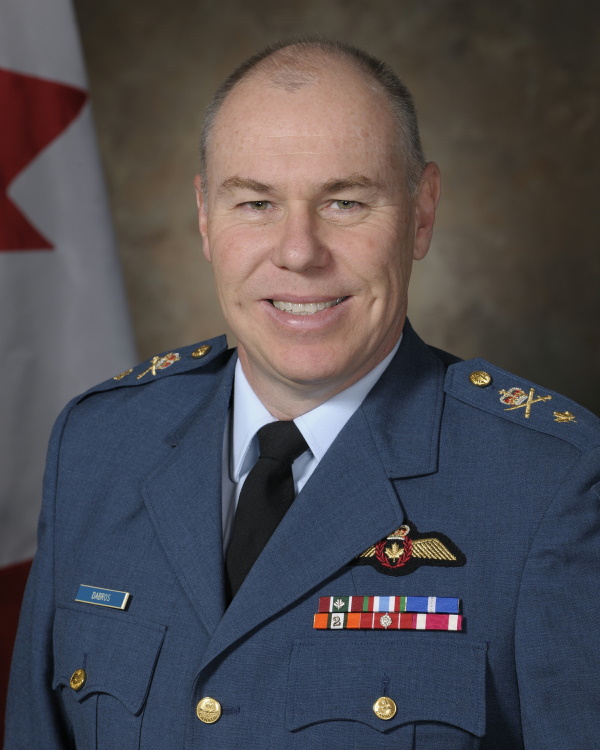
Mike is from Ottawa, where he served five years as a Naval Reserve signalman, from 1974-1979, and graduated with his BSc from Carleton University in 1981. Enrolling in the Regular Force as a pilot in February 1982, he commissioned that same year as a Direct Entry Officer. On completion of training, he was awarded pilot's wings at 3 CFFTS Portage La Prairie in April 1984, and completed a conversion to the CH135 Twin Huey three months later.
From 1984 to 1987 he was posted to VU32 Squadron in Shearwater, NS, as a CH135 line pilot - a tour that included a six-month peacekeeping deployment with Roto 1 of the Canadian Contingent Multinational Force and Observers/Rotary Wing Aviation Unit (CCMFO/RWAU) in 1986. In 1987 he completed tactical training on the CH135 and was posted to 427 Tactical Helicopter Squadron, Petawawa, where he served in various line appointments from 1987 to 1990. During this time he returned to the Sinai as the CCMFO/RWAU Roto 6 Operations Officer, and on his return from Egypt in the spring of 1989 completed the CF Staff School in Toronto.
Mike was posted in 1990 to National Defence Headquarters in Ottawa, where he served with the Directorate of Personnel Careers (Officers) until 1994, receiving a promotion to the rank of Major in 1993. From 1994 until 1997 he was posted to the North American Aerospace Defence Command (NORAD) in Colorado Springs, serving one year with the Cheyenne Mountain Operations Centre Staff Group, and two years with the NORAD Headquarters J5 Requirements staff at Peterson Air Force Base. He returned to Canada in 1997 and attended the Canadian Forces Command and Staff College (CFCSC) in Toronto, following which he was posted to 403 (Helicopter) Operational Training Squadron, Gagetown as the squadron operations officer, and flying the CH146 Griffon helicopter. On promotion to the rank of Lieutenant-Colonel in 1999, Mike was posted to 1 Wing Headquarters, Kingston, assuming the responsibilities of the 1 Wing A7 Plans, Doctrine and Requirements, and eventually as the 1 Wing Chief of Staff in August of 2001. He assumed command of 427 Tactical Helicopter Squadron in August 2002, and commanded the Roto 12 OP PALLADIUM TFBH Hel Det in Bosnia in 2003. He left 427 Sqn for attendance on the Advanced Military Studies Course in August 2004.
Promoted to full Colonel in February of 2005, Mike served as a member of the Chief of Defence Staff's Action Team studying Force Generation issues related to CF transformation until the end of June, 2005, at which time he assumed command of 1 Wing, Home of Canadian Tactical Aviation. In August of 2007 he commenced a year of professional studies that included French Language training at the Royal Military College of Canada, and the National Security Studies Programme at the Canadian Forces College.
On graduation in July 2008 he assumed command of the Canadian Forces Aerospace Warfare Centre, and in August 2009 completed the course work required for a Masters in Defense Studies from the Royal Military College of Canada. In late August of that same year Mike was posted to Afghanistan on a one-year assignment as the Deputy Commander of the NATO Air Training Mission in Kabul, mentoring Afghans in the creation and stand-up of their new Air Force.
Returning to Canada in September 2010, Mike was promoted Brigadier General and became the first aviator to fill a senior appointment on the staff of the Canadian Army Commander as Chief of Staff Land Operations, overseeing and coordinating the activity of the strategic-level continental staff, providing the primary interface between the Canadian Army and subordinate headquarters in executing current ops and responding to contingencies, and providing Army representation to key strategic-level decision-making and advisory bodies. In 2012 he was posted to London, UK, as Commander of the Canadian Defence Liaison Staff and responsible to the Vice Chief of Defence Staff for providing primary liaison between Canadian Defence interests and the UK Defence structure, to include the MoD, the Services, Joint agencies and Defence industries as well as to the broader UK defence attaché and liaison community. In addition, he served as primary advisor to the Canadian High Commissioner in London on Defence matters.
In early 2014, and having completed 36 years of Regular and Reserve Force service, Mike retired from the Canadian Forces to the 1000 Islands area. In retirement he has spent some of his time consulting on various Canadian Forces training events, courses and projects, as well as assisting a local start-up brewery as the member of their Board of Directors responsible for brewery operations and product development (2014-17). In addition, Mike is active as a volunteer in the community as the Chair of the Board of the Kingston Division of the non-profit Canadian Corps of Commissionaires, as well as a member of the Canadian Corps of Commissionaires National Board of Directors. He continues to enjoy travelling and spending long days doing all-grain brewing as opportunities permits.
He is married to Jean Dabros (formerly McNaughton) and they have three beautiful and talented daughters: Dana, Emilie and Meg.
Commanding Officer, 427 Special Operations Squadron, 2006 -2008
***UPDATED***
Major-General Christian Drouin OMM MSC CD
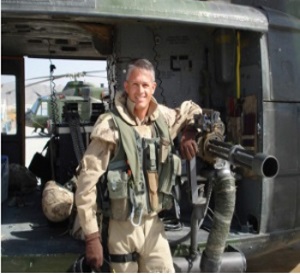
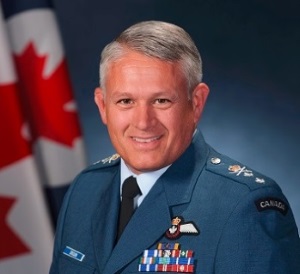
MGen Drouin was born in Montreal, Quebec in 1965. He graduated from College de Bois-de-Boulogne
in 1986 with a diploma in Human Science and Maths.Following the awarding of pilot's wings in March 1989, Major-General (MGen) Drouin was successively posted to 430 Tactical Helicopter
Squadron (430 ETAH) in Valcartier, Québec, as a line pilot. He was then posted to 403 Helicopter Operational Training Squadron in Gagetown,
New Brunswick, as an Instructor Pilot. He was also part of the Griffon helicopter fielding and implementation team to include the fielding
of the CH-146 Griffon Flight Simulator.
In 1990, MGen Drouin deployed to Central America as part of the 89th Rotary Wing Aviation Unit to assist in the demobilization of the
Contras in Nicaragua (ONUCA). In 1997, he was promoted to Major and posted to 1 Wing Headquarters (HQ) in Kingston where he assumed
the Wing Standards Officer position. From 1999 to 2003, he was posted back to 430 ETAH where he served as the Operations Officer.
Then from December 1999 to June 2000 he was the Deputy Commander of the Kosovo Rotary Wing Aviation Unit. In 2001, he commanded the
Canadian Helicopter Detachment in Bosnia-Herzegovina. In 2002, for six months, he was also privileged to assume command of 430 ETAH.
In 2005-2006, he was deployed to Kabul, Afghanistan as part of the first Strategic Advisory Team. From 2006 to 2008, MGen Drouin had
the honour and privilege of commanding 427 Special Operations Aviation Squadron out of Petawawa, Ontario.
He then served as a member of the Strategic Joint Staff as the Coordinator for Director Current Operations. MGen Drouin commanded
JTF-Afghanistan Air Wing-TF SILVER DART from November 2009 to September 2010 and then immediately assumed Command of 1 Wing (AVN BDE).
MGen Drouin completed the Air Force Command and Staff Course in Winnipeg in 1996, the Canadian Land Force Command and Staff Course in
Kingston in 1997, and the Australian Command and Staff College Course in 2004. He is an honour graduate of the Royal Military College
of Canada with a Bachelor Degree in Military Art and Science. He is also a graduate of the University of Canberra Australia with a
Master's degree in Management and Defence Studies and a 2013 graduate of the National Strategic Program at the Canadian Forces College
in Toronto.
In Aug 2013, he was promoted to Brigadier General and became the Deputy Commander Force Generation at 1 CAD/CANR in Winnipeg. In June
2015, he was posted as the Deputy Director of the Strategy, Policy and Plans Directorate North American Aerospace Defense Command (NORAD)
and United States Northern Command (USNORTHCOM), Peterson AFB, Colorado. MGen Drouin was promoted to his current rank on May 24th, 2016,
and appointed Commander 1 Canadian Air Division/Canadian NORAD Region on June 21st, 2016.
MGen Drouin has over 4000hrs Tac Hel flying time mainly on the CH-135 Twin Huey, the CH-136 Kiowa, and the CH-146 Griffon.
An accomplished athlete, Lieutenant-Colonel Drouin completed approximately 25 marathons, over 50 triathlons, nine Ironman distance triathlons
and one World Triathlon Military Championship. He was recognized as the athlete of the year at Canadian Forces Base Gagetown both in 1994 and 1995.
He also won the Quebec Regional Golf Championship both in 1991 and 2004.
Lieutenant-Colonel Drouin is married to Caroline and is the father of two boys, Guillaume and Alexandre.
Flying Officer Richard (Dick) Dunn SSM - 427 Squadron 1961
RCAF Service from 1959 to 1965
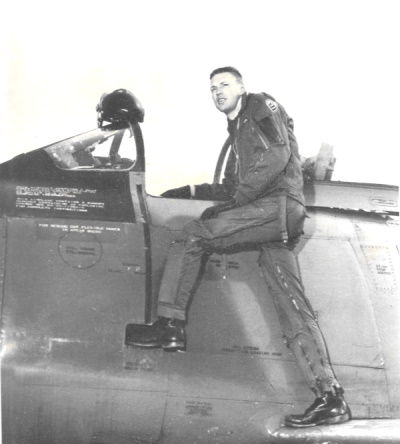
Born: Vancouver, BC 17 December 1940
1. Early days- Air Cadets
At 12 years of age, I joined the Boy Scouts, restlessly awaiting my 14th birthday at which age I was eligible to join the Royal Canadian Air Cadets. The highlight of my first Air Cadet summer camp was a familiarization flight in the Beechcraft Expeditor. Allowed to manipulate the controls in the co-pilot’s seat, I initiated a left diving turn, followed by a right climbing turn. “Thank you Sir, I really like flying,” I exclaimed, as I returned to the passenger cabin. Violent summer thermals tossed the aircraft like a bouncing ball as I filled two airsickness bags. Staggering off the aircraft, I doubted that I would ever achieve my goal of fighter pilot, but happily, that one occurrence of airsickness was my first and last.
2. Flying scholarship
Awarded a flying scholarship in 1958, I joined 25 other cadets for flight training on the Fleet Canuck at the Vancouver Flying Club. After 6 hours of dual, I experienced the thrill of my first solo flight, followed by the inevitable soaking upon landing. Awarded the trophy as the best student pilot in British Columbia, I soon added to my 30 hours by flying my schoolmates on sightseeing trips.
3. Royal Canadian Air Force
Mid August 1959, I boarded the Canadian Pacific Railway enroute to the RCAF Personnel Selection Unit at Centralia, Ontario, and was soon comfortable with the dazzling array of silverware in the First-class dining car as I tucked into the railway's fine fare. Of the successful applicants at Centralia, most were destined as navigators, but the 60 hours in my logbook gave me a considerable edge for pilot selection. Following basic training, six Norwegians joined our course as we commenced primary flight training on the De Havilland Chipmunk. In April 1960, our course #5916 transferred to Penhold, Alberta for advanced training on the Harvard.
In December 1960 the surviving students transferred to Portage La Prairie, Manitoba for jet training. Bundled in bulky winter flying suits, we successively strapped into the practice ejection seat, pulled the trigger, and a half charge of dynamite blasted us up the tower. Airborne in the T-33 jet trainer, I found my element, proceeding through the syllabus of aerobatics, spins, formation, navigation, and night flying. I had a good rapport with my instructor Bill McMurray, and after I graduated top of the class, he recommended me for one of only two slots available on the F-86 Sabre.
In June 1961 I checked into the F-86 Sabre Operational Training Unit at Chatham, NB. As there was no dual trainer, the first flight in this legendary fighter was solo. The training syllabus covered air fighting, now known as Combat Air Maneuvering, low flying, navigation, air-to-ground, and air-to-air gunnery.
4. Transfer to European NATO service
Dave Girling and myself boarded a sleek Comet of Air Transport Command, and after stops in Gander, and Shannon, arrived at Marville, France, where a staff car drove us to #3 Wing, Zweibrüken, West Germany. It was November 1961 with the cold war at its coldest, for the Ruskies, and their “Ossi” stooges had recently erected the infamous Berlin Wall; with the Cuban missile crisis following soon thereafter. I was greeted at the Officer's Mess by a group of genial pilots who informed me that I was to join 427 Squadron, rather than 434 as my orders had specified. The change was in consideration of the number of single pilots living on base, and their ability to respond quickly in the event of an alert. So unexpectedly, I joined the renowned “Lion” Squadron where I met and made life long friends of the Single Men's Union, Dale Horley, Walt Pirie, Larry Hill and Garth Mawhinney.
427 Squadron disbanded in December 1961, and I transferred to 441 Squadron at Marville, France. Flying as my wingman, Jack Davidson had a curious malfunction with frozen controls. After going through the bailout checklist, he blew the canopy and immediately ejected without shutting off the engine. I had to pull up sharply to avoid his aircraft as it banked towards mine and then entered a powered spiral dive. Not wanting to spear Jack on my pitot tube, I remained high until his aircraft disappeared into low clouds; where it subsequently crashed into a small village, killing a cow, and two chickens, but fortunately, no people. Spying his 'chute, I followed him down, transmitting directions to the rescue helicopter as he drifted over a church steeple and alighted in a forest outside a village.
441 Squadron disbanded in September 1963, and I transferred to 439 Tiger Squadron under the command of my first “Boss,” at 427 Squadron, the extraordinary leader, Wing Commander Pete St. Louis.
5. Training Command & Air Canada
Returning to Canada in November 1963, I attended Flying Instructor School at Portage and then reported to Gimli, Manitoba, where I met another long time friend, Ross Mayberry. Aware of my propensity for flying, Russ Bennett, my Flight Commander assigned me three students, thereby ensuring that my flying hours increased at a rapid rate. In October 1964 I recorded 103 hours, of which 83 were instructional hours. Scarcely believing, “Red” Dagenais of Base HQ visited “D” flight to verify my logbook.
October 1964 Jack Davidson flew into Gimli on his farewell tour, and told me that Air Canada was hiring pilots. I replied, “I am a fighter pilot and am not interested.” However in the intervening period, the RCAF had downsized, compelling early release for 500 aircrew. With that fundamental change in disposition, I along with many others felt that the RCAF was no longer attractive as a long-term career. During the summer of 1965, Dale Horley alerted me that Air Canada was hiring again, so I flew a T-33 to Montreal, where Captain Gath Edwards, gave a perfunctory interview, asking, “When can you start?” With that offer, I joined Air Canada in September 1965, once again graduating at the top of class, thereby assuring a charmed seniority number for the balance of my aviation career.
I had only single engine flying experience, soon redressed by the excellent tutelage of my instructor Roy Yates, a fine gentleman and pilot. Based in Montreal, my first airline flight was with Captain “Wendy” Reid, who I learned later, had flown Churchill during WWII.
6. Rapid advancement.
After a year flying the Maritimes, Air Canada's rapid expansion resulted in accelerated advancement, and in early 1966 I commenced training as a DC-8 First Officer, transferring to Vancouver in 1969.
Then it was back to Montreal for promotion to DC-9 Captain in 1973. In November 1976 four pilots including 427 Ron Stewart and myself were seconded to Air Jamaica to mentor local pilots. Presently my eight-month assignment expired with the option of staying on for another year. However, I decided I was not getting any smarter sitting under the palm trees, declined the option and returned to Montreal, where I resumed my geological studies at Concordia University.
7. B727 & Helicopter
While attending ground school converting to the B727 in April 1979, I simultaneously enrolled in a helicopter flight school. After completing the daily 727-ground school lesson, I would cross the river to St. Hubert for a flight in the Hughes 269. After I accumulated the required 25 hours and passed the flight test, I received a Commercial Helicopter License in the mail. I had expected only a Private License, and although I did not send it back, I certainly did not consider myself commercially qualified. In the fall of 1979 I once again transferred to Vancouver, flying the B727 until down bidding to B747 First Officer the following spring. In the early summer of 198O, I purchased a used Hughes 269C from a flight school at Kingston, Ontario. As I had not flown a helicopter for over a year, the chief pilot insisted I would need a refresher of about five hours before he would release the aircraft. That was fine with me, but after a one hour flight, he said, “I am satisfied, if you are.”
8. B747-200 First Officer
September 1981 found me enroute to Casablanca, Morocco for a two month “Hadj.” Our Air Canada B747 was “wet” leased to Royal Air Moroc to carry Moslem pilgrims to Jeddah. Our billet at the beachside Meridien Hotel reminded me of a Club Med, with attractive flight attendants, fine restaurants, swimming pool, tennis courts, sandy beach, etc.
At the end of the first phase, we had 10 days off pending the second phase to return the pilgrims to Casablanca. I had exchanged my deadhead ticket for a stopover in Cairo. My future wife Danielle joined me for cruise from Aswan to Luxor. The assassination of President Anwar Sadat compelled the cancellation of a planned flight to Abu Simbel.
9. L1011 Tri-star
Thanks to a number of pilots retiring early, in autumn 1989 I converted to the L1011 Tri-Star, relishing the stimulating destinations of London, Berlin, Bombay and Singapore. Westbound under a blue sky over the glaciers of Iceland, suddenly the left engine stopped. First Officer Dave Spicer received clearance to land at Reykjavik, as the Winnipeg cabin crew quickly and efficiently prepared the aircraft for an emergency landing. The engine had stopped so abruptly that we were perplexed as to the cause. But as the other two engines were humming along nicely, we acquiesced to Flight Dispatch's request to divert to Prestwick, and then to London. We subsequently learned that the spline drive powering all ancillaries, i.e. fuel pumps, generator, hydraulic pumps, pneumatic pump, etc had sheared, hence the abrupt flame out.
11. B767
When Air Canada retired the L1011 fleet in September 1991, Dale Horley and myself were selected as Captains for a possible assignment flying a Tri-Star between Nigeria and London. The job failed to materialize, but my conversion course to the B767 was put on hold for 5 months, during which time I visited my geologist friend Larry Dekker in Santa Cruz, Bolivia, My extended hiatus over, I converted to the B767 in early 1992, enjoying a great variety of destinations, ranging from Hawaii, to the Caribbean and Europe.
For 3 or 4 years, Toronto flight crew had been deadheading to Vancouver, laying over, flying to and from Hong Kong, Osaka, or Seoul, and then deadheading back to Toronto. Finally some bright bean counter of Air “Eastern” Canada decided that it would be sensible to open a B747-400 crew base in Vancouver. In February 1996 I commenced ground school conversion to the massive B747-400.
12. Bermuda
In late 1996 Air Canada replaced the B747-400 with the Airbus 340 on all oriental routes. Rather than converting to the “plastic” airplane, I chose to continue flying the -400, necessitating a transfer to Toronto. Declining to reside in the self appointed “World Class City,” Danielle took a leave-of-absence and we moved to Bermuda, renting a condo a stone's throw from the waters edge.
After a year, Danielle tired of sitting around Bermuda, and returned to flying. On one of her flights, a pilot said, “We don't envy Dick for his exalted seniority, nor for his gorgeous wife, but we envy him because he doesn’t need glasses.” My keen eyesight was a key element in my enjoyment of flying, never a job, but an avocation. Flying requires three focal points, close-up to view the charts, mid-range to view the instruments, and infinity to see other aircraft and the runway. Naturally my vision deteriorated from my teenage days, but at retirement, I still qualified as 20/20 uncorrected, albeit with a little squinting.
13. Last Flight-November 2000
Danielle and I joined the crew in the lobby of the Mainz River Hilton where we assembled for a group photo in front of the Christmas tree. Avoiding Frankfurt, the “Detroit” of Germany, most airline crews layover in Mainz, a safe, ancient town laced with walking streets. Boarding a comfortable bus, we relaxed on the 25-minute drive to Frankfurt airport where we boarded a B747-400 for my last flight to Toronto.
After landing, we left the flight deck and entered the upper cabin, as Captain Rob Giguere, Vice President Flight Operations, greeted me and presented a commemorative engraving marking the end of my career with Air Canada. As we exited Canada Customs, we were met by a welcoming group of pilots and friends.
Thus ended my professional aviation career. Notwithstanding a few engine failures and diverse emergencies, my 22,000 flying hours were completely accident free, with not so much as a blown tire on my record. This accomplishment may have deprived me of my proverbial 15 minutes of fame, but in aviation, boring is good. Well boring, it was not, but it was a “charmed” career. Throughout my 43-year avocation, luck played a part, but first-rate training, competent co-pilots, and excellent maintenance played the major role.
14. Soaring course August 2001
Hope is where it was. The gliding that is. Mid August 2001, I joined 5 retired airline pilots for intensive flight training with the Vancouver Soaring Association. As prevailing westerly winds funnel up the Fraser Valley, unrivaled updrafts are created as the steep slopes of the Coast Mountains block the flow.
With three instructors, five gliders, and two tow planes flown by retired CP Air pilots Bill Green and Bob Ayotte, the daily routine was reminiscent of my youthful flying in the air force. On the three parallel runways, tow planes and gliders launched, landed, re-positioned and re-launched in a continuous aerial ballet.
Strapping on my parachute preparing for a spin session, my partner Jack Humphries asked, “Why am I laughing?” I replied, “Because here I am, 60 years old, doing what I did at 17, and loving every bit of it.” With the brisk schedule, there was not much time for soaring, but on my penultimate flight, I dropped the tow line at 1,000 feet and worked my way to 4,700 ft in somewhat over an hour for a very satisfying soaring session.
Much as I enjoyed glider flying, I decided it was not the sport for me. With the slick, modern aircraft now available, it is not that difficult to attain the various challenges of time, distance and height, the greatest hurdle being how long your bladder can hold out. After 35 years in a sedentary occupation, I felt my retirement years would be better served with an activity demanding more physical exercise. Thereafter, I considered my aviation career concluded and have moved on to other pursuits, primarily hiking along historic paths. See my book
“A Journal of Journeys”on my website for examples.
Dick
Richard Dunn
Membership Chair - Treasurer
427 Lion Squadron Association
Commanding Officer, Squadron, 1988-1990
Lieutenant-General(R) Eric A. Findley CMM MSC CD
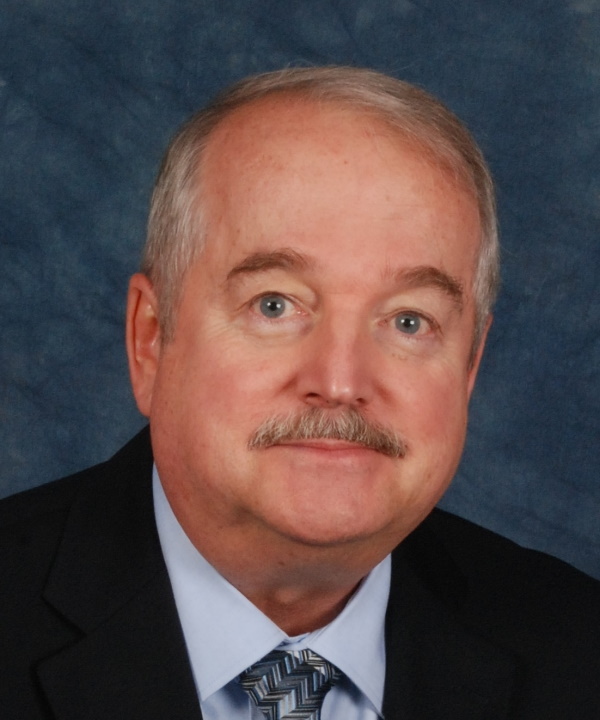
Born in Ottawa, Ontario in 1950, Lieutenant-General (retired) "Rick" Findley entered the Canadian Forces in 1968. Trained as a pilot, he flew with 408 Squadron, Edmonton; 444 Squadron, Lahr, Germany; 403 Squadron, Gagetown; and 427 Squadron, Petawawa. During peacekeeping operations, he commanded and flew with United Nations (UN) and Multinational Force and Observer (MFO) aviation units in the Sinai, Central America, and Haiti. The logbook reflects over 4600 flying hours, primarily in helicopters. He has commanded 427 Squadron, and 7 Wing Ottawa. He has commanded two Canadian peacekeeping contingents, and served as Chief of Staff and Acting Force Commander for the MFO. His last command appointment was as Deputy Commander North American Aerospace Defence Command (NORAD) and Head of the Bi-national Planning Group.
Staff experience includes service as Senior Staff Officer Plans, Doctrine, and Requirements with HQ 10 Tactical Air Group; Staff Officer in the Directorate of Peacekeeping Operations and National Defence Operations Centre at National Defence Headquarters; Chief of Staff for Personnel, Training, and Reserves (A1) at Air Command Headquarters and 1 Canadian Air Division; Chief of Staff for Operations (A3) at 1 Canadian Air Division/Canadian NORAD Region; and Director of Combat Operations (NJ3) at HQ NORAD in Colorado Springs. Lieutenant-General Findley is a graduate of Carleton University (BSc); the Canadian Forces College; the Royal College of Defence Studies (UK); the Combined Forces Air Component Commander's Course (USA); and the National and International Security Studies Program at Harvard University.
Awards and decorations include Commander in the Order of Military Merit; Meritorious Service Cross (for action taken during terrorist attacks of 11 September 2001); Special Service Medal for duty in NATO; Peacekeeping Medals from UN missions in Central America and Haiti; the MFO medal for service in the peacekeeping mission in Egypt/Israel; the Canadian Peacekeeping Medal; the Canadian Decoration; Officer in the United States Legion of Merit (for exceptional meritorious conduct in the performance of duties with NORAD); Oregon Exceptional Service Medal; and the US Army Commendation Medal. Lieutenant-General Findley is the first Canadian officer to have a US Combatant Command building dedicated with his name. He shares this honour with USAF General Ralph E. Eberhart. HQ NORAD/USNORTHCOM has been named the Eberhart-Findley Building.
Lieutenant-General Findley retired from the Canadian Forces in September 2007, and resides in Nova Scotia. As a consultant he has lectured on command and leadership at the operational level; served as a facilitator for the DND Executive Leadership Program; served as a facilitator for the Canadian Security Studies Program; served as a mentor and exercise Commander Combined Joint Task Force for exercises at Canadian Forces College, Toronto, and Rapid Reaction Corps - France, in Lille, France; and participated as a member of the Space Operational Planning Team for the RCAF.
He is married to Carla Findley of Greenwood, Nova Scotia.
Commanding Officer, 427 Special Operations Squadron, 2018-2020
Lieutenant-Colonel Jeremy Fountain CD
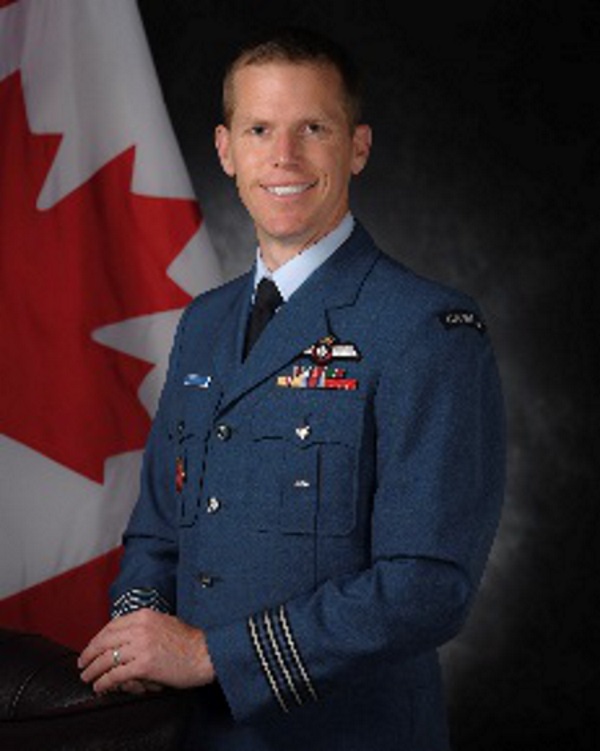
LCol Fountain was born on the 15th of April 1976 and considers Kirkland Lake, Ontario his hometown. He joined the Canadian Armed Forces as a Direct Entry Officer in 1999 and received his Wings in August of 2003.
LCol Fountain's operational experience includes two postings to 427 Special Operations Aviation Squadron and three years with 9 Regiment British Army Air Corps. He has twice deployed to Afghanistan, first as the Canadian Special Operations Forces Aviation Liaison Officer in Kandahar and then again as Officer Commanding 659 Squadron Army Air Corps, flying the Lynx Mk 9A helicopter in Helmand Province. In addition to his tours in Afghanistan, LCol Fountain has deployed to Iraq flying the Lynx Mk 9 from Basra and on numerous exercises across Africa, the UK and North America. For his service on operations, he has earned commendations from both the Commander of Canadian Special Operations Forces Command and the Commander-in-Chief, UK Land Forces.
LCol Fountain received his Honours Bachelor of Science degree from the University of Waterloo with minors in Physics and Chemistry as well as a Masters in Defence Studies from Royal Military College. LCol Fountain is a graduate of the Army Operations Course and the Joint Command and Staff Program. His staff experience includes postings to 1 Wing Headquarters as A3 Operations and Canadian Joint Operations Command as the J3 Africa Regional Head.
With over 2800 flying hours, LCol Fountain is passionate about aviation, flying both at work and on his own time. He is married to an amazing wife, Maj Jennifer Fountain, and has two awesome boys, William and Joel who have already begun their flight training!
Brigadier-General (R) Edward H. Gosden CMM CD
Commanding Officer, 427 Squadron, July 1985 to September 1986 and April 1987 to July 1988
Military Service 1964 to 2000
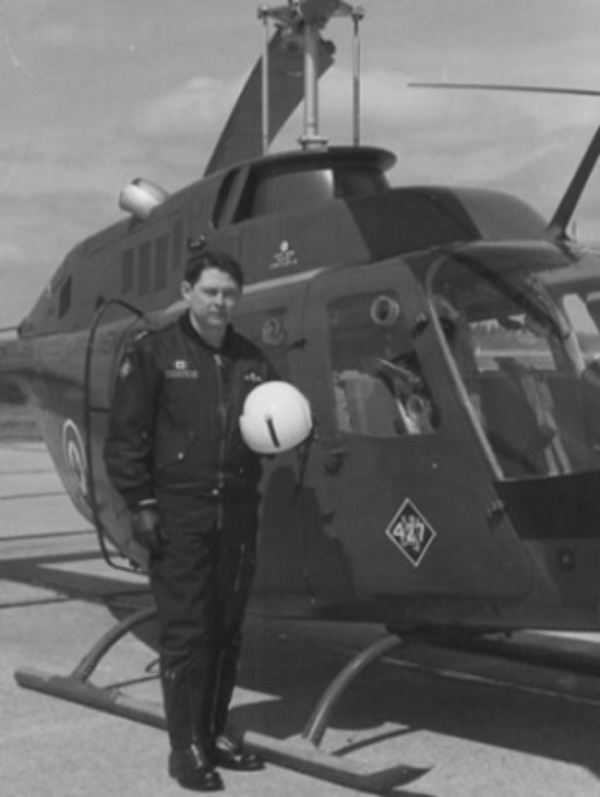
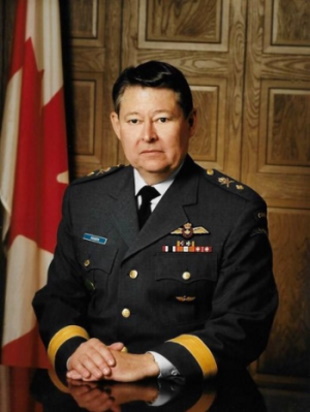
Brigadier-General Ed Gosden was born in Outremont, Quebec, in 1946. He enrolled in the Royal Canadian Infantry Corps in September 1964. One year later, he joined the 1st Battalion, The Canadian Guards, Camp Picton, Ontario, where he served a three-year tour as an infantry platoon commander. In 1968, he was posted to the 2nd Battalion at Canadian Forces Base Petawawa, Ontario where he served as the Mortar Platoon Commander. He is a qualified parachutist and a graduate of the U.S. Army Special Forces Officer Course. He was promoted to Captain in September 1969 and subsequently attended the Canadian Forces Staff School, Toronto, in November 1970.
Brigadier-General Gosden commenced pilot training in March 1971. On graduation from 1 Canadian Forces Flying Training School he was posted to 427 Tactical Helicopter Squadron at CFB Petawawa, Ontario. In 1975 he attended the Junior Command and Staff Course (Land) in Kingston, Ontario.
In August 1976, Brigadier-General was posted to 444 Tactical Helicopter Squadron in Lahr, Germany. This tour was cut short when, in February 1978, he was posted to an exchange position with 657 Squadron, Army Air Corps, Oakington Barracks, Cambridgeshire, UK. During this tour he was the Anti-tank Flight Commander. He was promoted to the rank of Major in July 1979. On return to Canada in June 1980, he was posted to HQ 10 Tactical Air Group at St-Hubert, Quebec. During a three-year tour, he held the staff appointments of Staff Officer Plans and Doctrine followed by Staff Officer Training.
In August 1983, Brigadier-General Gosden attended the Canadian Forces Command and Staff Course, Toronto, Ontario. He was subsequently posted to 427 Tactical Helicopter Squadron in July 1984 and for one year held the appointment of Deputy Commanding Officer. On 28 June 1985, he was promoted to the rank of Lieutenant-Colonel and appointed Commanding Officer of 427 Squadron. Brigadier-General Gosden served a six-month peacekeeping tour as Commanding Officer of the Rotary Wing Aviation Unit of the Multinational Force and Observers, El Gorah, Egypt from September 1986 to March 1987.
In July 1988, Brigadier-General Gosden was posted to National Defence Headquarters, Ottawa where he held the appointment of Director of Land Aviation for a period of one year. He was promoted to the rank of Colonel in July 1989 and posted to the Canadian Forces College, Toronto, where he concurrently held the appointments of Director of Air Studies and Director of National Security Studies. In August 1992, he was posted to the Canadian Forces Language School, Ottawa, where he attended the one-year Continuous French Course.
In July 1993, Brigadier-General Gosden assumed the appointment of Commander, Canadian Contingent, Multinational Force and Observers, El Gorah, Egypt. He filled the staff appointment of Chief of Operations and Liaison within the Force Headquarters. On 9 August 1994, Brigadier-General Gosden was appointed Deputy Commander 10 Tactical Air Group and concurrently Commander 11Wing.
On 19 July 1996, he was promoted to the rank of Brigadier-General and on 6 August 1996 assumed the appointment of Commandant, Canadian Forces College. Brigadier-General Gosden is married to the former Alfreda Portelli of Toronto, Ontario; they have a daughter who is a CF military police officer, Carol Ann, and a son, Kevin.
On 7 July, 2000, Brigadier-General Gosden retired from the CF and took up residence in Orangeville, Ontario. He subsequently joined the federal public service with Public Safety Canada in Toronto where he filled the appointment of Regional Coordinator, Ontario for the National Critical Infrastructure Assurance Program.
In June 2010 he fully retired and he and Freda are happily living in Orangeville, Ontario
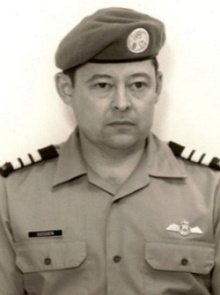
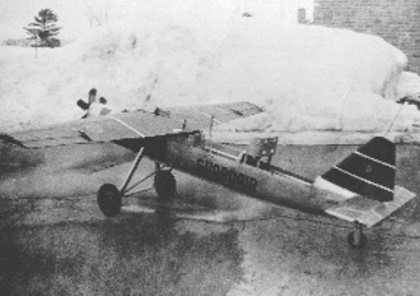
Link to the GUARDAIR story
Link to BGen Gosden's photos
Honorary Colonel Lianne Ing, 2018 -
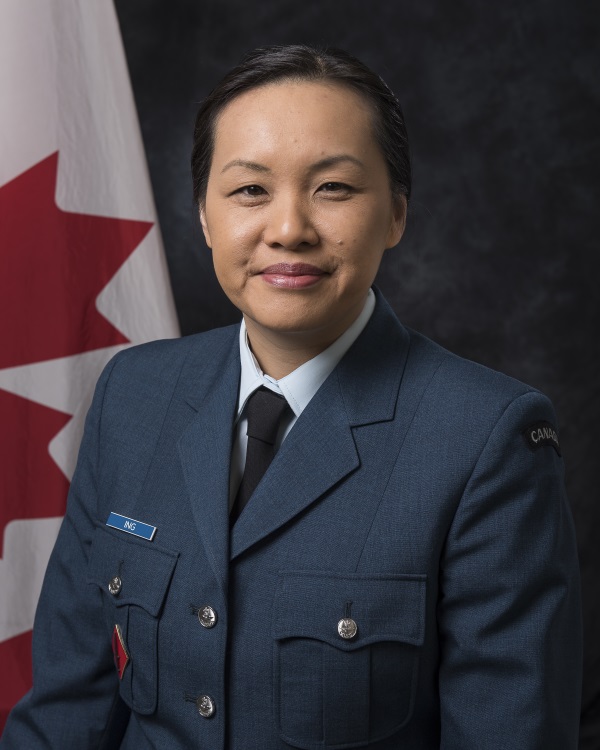
Lianne Ing is Vice President of Bubble Technology Industries (BTI). Founded in 1988 and located in Chalk River, Ontario, BTI is a 100% Canadian-owned and operated small business with world-renowned expertise in the field of radiation and explosives detection. With a multi-disciplinary staff of ~50 people, the company provides products, services, and contract R&D for over 400 customers in 25 countries, with key clients including the US Department of Homeland Security, US Department of Energy, the Canadian Department of National Defence, the Canadian Space Agency, multiple law enforcement agencies, and a wide range of other Canadian and NATO-country agencies. The company's innovative technologies have flown on over two dozen space missions and have been used to secure high-profile events, including US Presidential inaugurations, visits by the Pope, global political summits, multiple Super Bowls, NASCAR events, the World Series, and the Olympics.
As Vice President, Ms. Ing is responsible for the company's strategic development and business operations. This role includes strategic planning and implementation, business development, financial and contract management, and oversight of the company's activities in research, engineering, manufacturing, and services. Since joining the company in 2003, she has served as Manager of Business Development, Vice President of Business Development, and now Vice President of the company. She has successfully led the company's penetration into international defence and security markets through both contract R&D and product sales channels. In addition, she has developed and negotiated partnering agreements with multiple Fortune 500 companies and has created collaborative technology development teams with stakeholders from government, industry and academia.
Ms. Ing serves on the Board of Directors for the Canadian Chamber of Commerce and is an active member of the Chamber's Small & Medium Enterprise Committee. She also served as a Canadian industry representative on both the Trade & Investment Taskforce and the Small & Medium Enterprise Cross-Thematic Taskforce for the 2017 B20 Summit, providing industry-driven policy perspectives to the 2017 G20 Summit held in Germany. She is also currently serving on the Public Services and Procurement Canada Supplier Advisory Subcommittee on Supplier Relationship and Performance Management, providing inputs to the Government of Canada on innovative ways to manage and engage with its supply base.
Ms. Ing has been an invited speaker and panelist at various events for professional associations, government programs and committees, and charitable organizations, including the Canadian Nuclear Association, Professional Engineers of Ontario, Canadian Nuclear Safety Commission Speaker Series, Build in Canada Innovation Program Forum, Eastern Ontario Development Program Forum, and Destination Imagination (promoting creative thinking for students in science, technology, engineering and mathematics).
Link to Report of Honorary Colonel Handover Ceremony- July 12, 2018
Commanding Officer, 427 Squadron, 1978 -1980
LIEUTENANT-COLONEL (R) J.E. JACKAMAN OMM CD
MILITARY SERVICE OCTOBER 1951 TO DEC 1987

Lieutenant Colonel Jack E. Jackaman was born and educated in London, England. He commenced his military career in the Royal Air Force, received his pilot's wings in December 1952 and subsequently completed training as a day fighter pilot. In 1954 he emigrated to Canada and joined the Royal Canadian Air Force. After a period of refresher training he was posted to 425 AW(F) Squadron. After four years as an All-Weather Fighter Pilot he was posted to 14 Aircraft Control and Warning squadron as a Fighter Weapons Controller.
In 1960, he attended RCAF Staff School and was posted to the Central Experimental Proving Establishment as a Test and Acceptance Pilot on the CF104 Starfighter Programme. During his four years as a Test Pilot he qualified on all the major jet fighter aircraft in the RCAF inventory at that time.
In 1965 he became a flying instructor in Tutor Aircraft at No 1 FTS, Gimli, Manitoba. Three years later, by then a Major, he was posted to the Central NORAD Region Headquarters, Richard Gebaur AFB, Kansas City, Missouri. During his tour as a Staff Officer in the Semi-Automatic Ground Environment Division, he qualified as a USAF Instructor Pilot on the T39 Sabreliner and T33 aircraft.
In 1969 Major Jackaman was appointed Chief Standards Officer of the Canadian Forces Officer Candidate School, Chilliwack and subsequently was appointed Deputy Commandant. In 1973 he attended the Canadian Forces Staff College and on graduation commenced training at the Combat Arms School in preparation for his appointment in army aviation as Operations Officer of 427 Tactical Helicopter Squadron, Petawawa, Ontario. He later served as Deputy Commanding Officer of the Squadron before his appointment as Commanding Officer of CFS Kamloops, B.C.
In 1978 he was promoted to Lieutenant Colonel and returned to 427 Squadron as Commanding Officer. In June 1980 he commenced a three-year tour as the Commanding Officer of the Canadian Forces Training Team providing support to the Ghana Armed Forces Staff College in Accra, Ghana. In June 1983 Lieutenant-Colonel Jackaman was appointed by Her Majesty The Queen to be an Officer of the Order of Military Merit and returned to Canada to take up his final appointment as Base Administration Officer, CFB Comox. He retired in 1987.
During his 36 years of military service he enjoyed a broad variety of flying jobs and qualified in over 20 different aircraft types and completed more than 5,000 flying hours. In addition to many ground appointments he was also privileged to command a Station, a Helicopter Squadron and an Overseas Training Team.
Jack Jackaman is now enjoying retirement in the Fraser Valley of B.C. with his wife of 56 years, the former Joan M. Horton of Croydon, England. They have three married children who have, at last count, produced five grandchildren.
Note:When I retired I retired completely, and enjoyed a variety of hobbies and interests. As an amateur radio operator I have been heavily involved in emergency communications for the Provincial Emergency program and have set up a fail safe communication system for the City of Chilliwack and Fraser Valley Regional District. My military training assisted me is obtaining some $35,000 from BC gaming grants to purchase up to date radios and computers for the Chilliwack Amateur Radio Club. It has all been very rewarding.
For the last five years I have been a full time care giver for my wife who suffers from advanced Parkinson's and dementia. As a result I am still a busy person but coping with my new responsibilities and developing new skills required as a care giver.
]See also Helicopter and Land Force Training - 1974-75
Jack Jackaman VE7HJJ
Squadron Chief Warrant Officer, 427 Special Operations Aviation Squadron 2022- 2024
SCWO Mark Jones
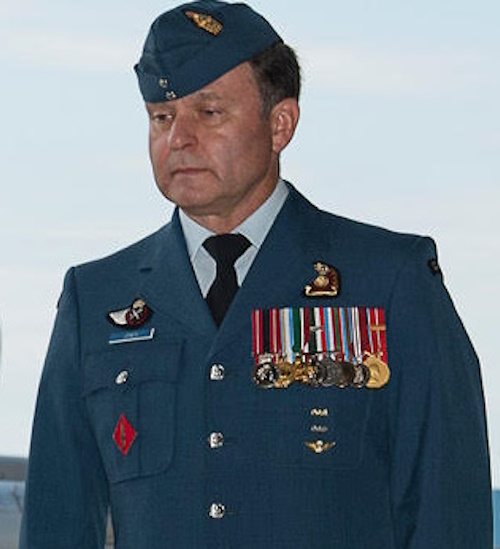
Born in Orillia, Ontario Chief Warrent Officer (CWO) Mark Jones joined the Hastings and Prince Edward Regiment in 1989. During his time as a reservist he completed the Non-Commissioned Officer training plan and was promoted to MCpl.
In February 1990 CWO Jones transferred to Gagetown, NB to attend the Royal Canadian Armoured Corps school where he completed his TQ3 Armoured Battle School. After the course he was posted to Recce Squadron, Royal Canadian Dragoons(RCD) in Petawawa,ON. In 1993 he was deployed on OPERATION DELIVERANCE, Somalia, as part of Assult Troop. In 1994/1995 he was deployed to OPERATION CAVALIER, Bosnia as a member of A Squadron, RCD.
Looking for a change CWO Jones transferred to CFSATE, Borden,ON for AVN Tech training and on completion was posted to 407 (LRP)Run-Up Squadron, Comox, BC in 1999. He was employed in servicing, maintenance, engine bay and as a Deputy Run-Up check out NCO. During his time at 407(LRP} Squadron he was deployed on OPERATION SERIUS, Sicily in 2004. He completed his basic and IEDD Operator courses at CFSAL at CFB Borden in 2006. In 2008/2009 he deployed on OPERATION ATHENA, Afghanistan as a Counter-IEDD Team Commander.
2010 saw him posted to 19AMS, Comox where he was employed as the Deputy Commander of the 19 Wing EOD/IEDD team. During his time there he completed his Advanced EOD course in the USA and deployed in 2013 on OPERATION RENDER SAFE, Solomon Islands. He was also seconded to be an assessor on the NATO Pre-Operational IEDD Operator course in Ireland.
In 2014 CWO Jones was posted to the Joint Counter Explosive Threat Task Force (JCET-TF}in Ottawa as the RCAF Senior EOD operator. During his timewith JCET he deployed to the Philippines to instruct on the Post Blast Investigation Course and lead many Mobilr Training Teams {MTT) throughout South East Asia and Mongolia.
CWO Jones was posted to CANSOFCOM as the Future Capabilities Integrator and in 2019he was appointed as the Squadron Sergeant{SSM} of HQ and Signals Squadron.
July 2022, CWO Jones was appointed SCWO of 427 SOAS in Petawawa.
He is the proud father of two amazing children, Alex and Megan.
Commanding Officer, 427 Special Operations Squadron, 2020-
Lieutenant-Colonel J.B.F. Lavertu
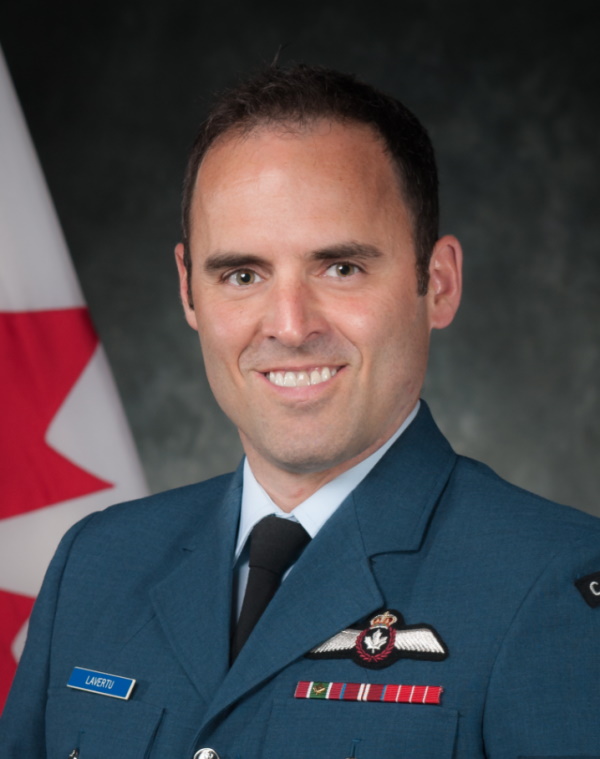
Born in Quebec City, LCol Lavertu joined the Canadian Forces in June 1996, under the Regular Officer Training Plan, after graduating from high school. He then spent the first five years of his military career at the Royal Military College, in Kingston ON, where he graduated with a B.A. in Politics and Economics.
Upon completion of pilot training in June 2005, LCol Lavertu was posted to 430 ETAH as a co-pilot on the CH-146 Griffon helicopter. Over the following years, he took part in numerous domestic operations and exercises that brought him to the four corners of Canada. He would, however, have to wait until August 2007 to participate in his first overseas deployment and join the 4th rotation of OP ATHENA as J3 Aviation for Joint Task Force – Afghanistan. Shortly after his return to Canada, LCol Lavertu began his training on the CH-147D Chinook helicopter and returned to Afghanistan in April 2009 as part of the Canadian Helicopter Force (Afghanistan) as the CH-147D Deputy Flight Commander.
He has served as Executive Assistant to the Deputy Commander Canadian Expeditionary Forces Command in Ottawa; as a Flight Commander during the standing up of 450 Tactical Helicopter Squadron; as the Wing A3 and as a staff officer in the Directorate of Structure Integration under the Chief of Force Development. He most recently served as the Senior Staff Officer Air/Director Special Operation Forces Requirement Air at the Canadian Special Operations Forces Command Headquarters.
LCol Lavertu is a graduate of the Land Force Command and Staff Course and the Joint Command and Staff Program. He also holds a Master of Arts in International Affairs from Carleton University.
LCol Lavertu lives in Ottawa with his spouse Stephanie, his son Nicolas and his daughters Bria and Eva, whom he thanks wholeheartedly for their patience, understanding and most importantly, love and support.
Flying Officer B.W.(Wayne) MacLellan SSM - 427 Squadron 1959-1961
RCAF Service from 30 August 1957 TO 26 September 1964
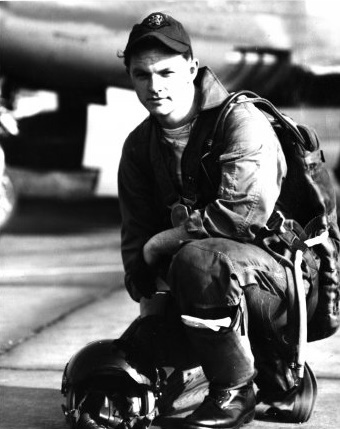
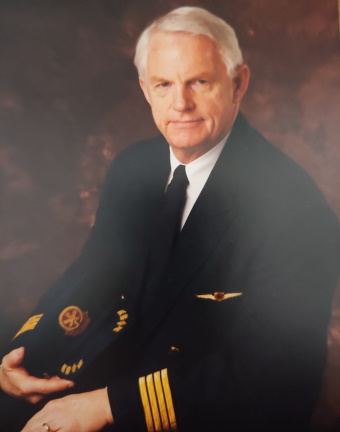
F/O MacLellan was born and raised in Stellarton, a Nova Scotia coal mining town.
In June 1957, Wayne graduated from Stellarton High School and immediately joined the RCAF in the day when Canada's NATO committment was twelve squadrons of fighters as well as an Army motorized brigade based in Europe. Selected for a short service commission and trained as a pilot he received his wings on December 1958 and received his dream posting, training on the F-86 (CL-13) at Chatham, NB.
On successful completion he was posted to 427 Squadron based at #3 (F) Wing in Zweibrücken, Germany. In that era there was always a palatable sense that it was only a matter of time before war broke out again and Squadron pilots continually prepared for that eventuality honing day fighter tactics learned in the Korean War.
In 1961 it was back to Canada as an T-33 Instructor at Portage La Prairie. Assignments at Portage included instructing, ground and air, standards officer and then as assistant Red Knight, a solo aerobatic display. He retired from the RCAF in September 1964 as a result of the planned consolidation of the forces.
Hired by the Australian legacy carrier QANTAS as a line pilot, Wayne and his family relocated to Sydney, NSW. However, he returned to Canada in 1966 after two years with Qantas and began flying with Air Canada. He was promoted to DC-9 Captain in 1974 and began as an DC-9 Instructor in 1981. In 1976 he began university and received his BA in 1983. In 1977 he joined the Canadian International National Airshow (CIAS) as a volunteer on their Air Committee and in 1980 became the Director Air Operations (CIAS) for a three year period. In 1987 he became Acting Manager of Flight Training, Air Canada and in 1989 was promoted to Chief Pilot 727, Winnipeg. Wayne left that position in 1990 to fill a secondment to Transport Canada in Ottawa for two years as Chief, Air Carrier Operations (National/International) as part of a Government/Business Exchange. Returning to Air Canada in 1992 he took on the post of Director Standards and Training, Flight Operations. Early in 1993 he successfully completed the Advanced Management Program (AMP) at Harvard and in 1994 he became Vice President-Flight Operations for Air Canada and retired in that position in 1999.
Throughout his management career in Air Canada he maintained his currency on an aircraft type, a Transport Canada requirement. He has logged over 16,000 hours and has been type rated on seventeen aircraft from a Chipmunk to the Boeing 747-200.
He is a member of the Air Force Association, Royal Canadian Legion and Royal Canadian Military Institute. He is also a member and volunteer with the 427 Squadron Association which recognized his service with the Lionheart Award in 2012.
Wayne was married at Zweibrücken to Beth Hodgson, a Canadian DND high school teacher in 1961 just prior to returning to Portage La Prairie. Their oldest, Janice, is a Senior Air Canada Captain; son Dr. Robb MacLellan is Professor of Medicine and Head Division of Cardiology, University of Washington and the younger son, James, is a partner at Borden, Ladner, Jervais in Toronto.
Maj(R) Bryon Mask , 427 Squadron, 1973-1976
Military Service 1968 - 1988
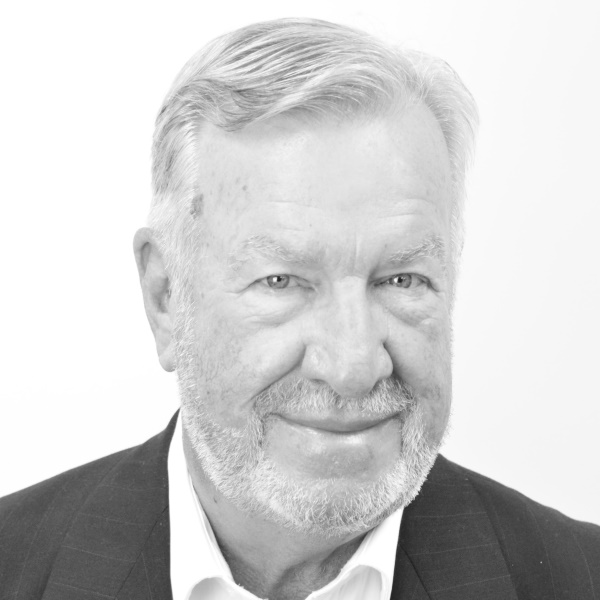
Bryon was born in Toronto as part of a military family. He enrolled in ROTP in 1968 and retired from the Air Reserves in 1988 with the rank of Major after twenty years of service in the military, flying both rotary wing and fixed wing aircraft. His last squadron task was Twin Huey flight commander during the Summer Olympics in 1976.
He was also with Air Canada for twenty six years both as a line pilot and supervisory pilot including the position of Manager of Flight Safety for Flight Operations. During his aviation career he has accumulated 20,000 hours of flying time.
Bryon is also a graduate of Dalhousie University. He is an accredited accident investigator,
having been seconded to the Canadian Aviation Safety Board Headquarters while with Air
Canada and has been involved in flight data monitoring (FDM) for 20 years with the airline
industry, and Applied Informatics & Research Inc. (AIRINC) in Ottawa where he currently holds
the position as Director of FDM.
He volunteers at the Aviation museum in Ottawa where six of the aircraft on display in the collection he has
flown including the Argus and Sea-King. An avid golfer he currently is a
member of Camelot Golf club in Ottawa and member of the Board of Governors.
Commanding Officer, 427 Squadron, 2003-2005
Colonel(R) Richard C. McLaughlin OMM CD
Director Air Reserve - Royal Canadian Air Force
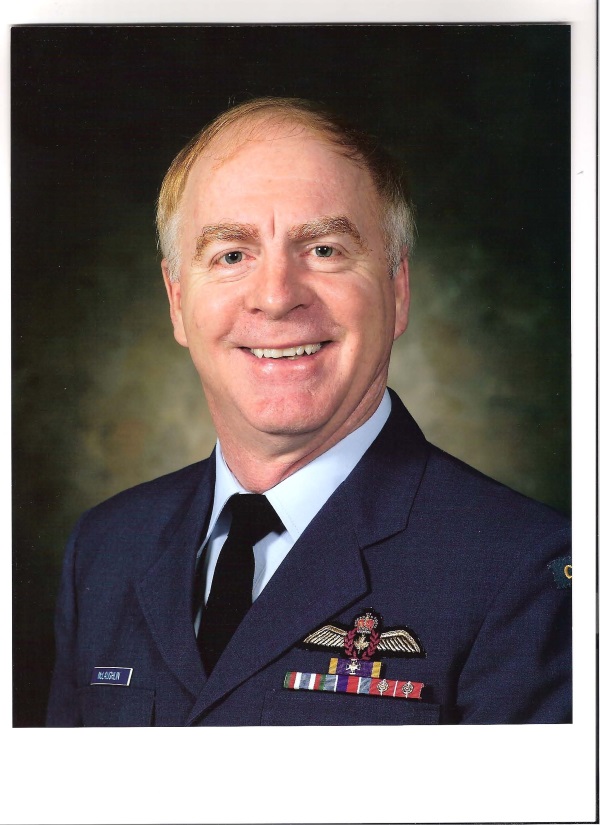
Colonel Rick McLaughlin assumed the responsibilities of Director Air Reserve in July 2013, and as such is responsible for monitoring and advising on all policy development within the Canadian Armed Forces that has a pan-reserve nexus.
Colonel McLaughlin joined the Canadian Forces in 1974 under the Regular Officer Training Plan. He attended Royal Roads Military College and graduated with a Bachelor of Engineering (Mechanical) Degree from the Royal Military College of Canada in 1978. He served in a variety of line positions as a pilot in the Tactical Aviation community, accumulating operational flying experience on the Twin Huey, Chinook, and Griffon helicopters with 427 Tactical Helicopter Squadron, Petawawa and 450 (Transport) Helicopter Squadron in Ottawa, Ontario. His operational experience included active parachutist duty with the Special Service Force HQ in Petawawa (1983-85), United Nations Tour of duty in Haiti (1995-96) and culminated with his appointment as the Commanding Officer of 427 Squadron in 2003.
National staff experience included two tours of duty with the Air Force Requirements Staff at National Defence Headquarters (1986-1989; 2005-2006) and an extended tour with the Associate Defence Minister (Material) as the Operational Requirements Manager of the Medium to Heavy Lift Helicopter Project (2006-2012). Colonel McLaughlin's Reserve Force service includes duties as the Air Reserve Flight Commander in 427 Squadron (1997-2005) and as a member of the Director of Air Reserve staff in Ottawa (2012-2013).
A Distinguished graduate of the Canadian Forces Command and Staff College (1994), graduate of Canadian Forces Staff School (1983), Canadian Land Forces Command and Staff College (1988), and the Canadian Security Studies Program (2013), Colonel McLaughlin was appointed to the Order of Military Merit in the grade of Officer in 2005.
Colonel McLaughlin resides in Renfrew Ontario, is married to Gayle (nee McGuire), and has two beautiful daughters and three wonderful grandchildren. He remains active in hockey, golf and enjoys travelling and cottage life with family.
Lieutenant - General(R) D.(Don)M. McNaughton CMM CD
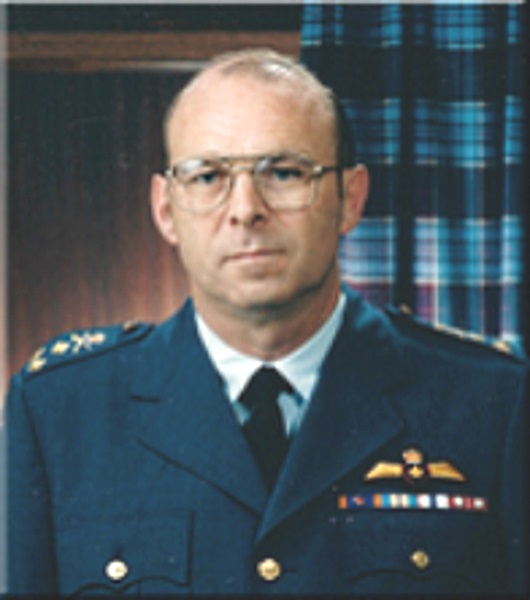
Don joined the RCAF in 1952 at age 18 and received his pilot wings in 1953. By the end of that year he was instructing NATO student pilots. He remained in the instructional field until 1958 when he was posted to the F-86 Sabre Operational Training Unit and subsequently to Air Division's #1 (F) Wing at Marville, France to serve with 439 Squadron. In 1963, he was returned to Canada and sent to a Flying Training School at Gimli, Manitoba as Chief Standards Officer and then as the Officer Commanding of the new Tutor Squadron when that aircraft was introduced in 1965.
In 1966, having enjoyed 14 years in the cockpit, he was posted to the Canadian Army Staff College in Kingston. After his graduation and then two years on the staff of Mobile Command Headquarters, he returned to the College to be a member of the Directing Staff for three years.
L/Gen McNaughton took the Kiowa course at Portage and the Huey course at Gagetown in 1972 before going to the UK to attend the RAF Air Warfare College for six months. He came back to Canada in the summer of 1973 and took command of 427 Squadron. These were the early days for the Tactical Helicopter Squadrons. Aircrew and groundcrew were a mix of ex Army, Navy and Air Force with an aircraft complement of six Hueys and eight Kiowas.
He was promoted to Colonel rank after one year in command and served in a series of positions: Mobile Command again, Deputy Commander of 10 Tactical Air Group, Deputy Commander of the Canadian United Nations Contingent in the Middle East and Base Commander of CFB Winnipeg. In 1978, he was Director General in the Air Branch in NDHQ and served there until 1981 when he became the Commander of 10 Tactical Air Group in Montreal. At that time, we had two CF-5 Squadrons, two Chinook Squadrons, and all the tactical Helicopter Squadrons. Again, after one year in command, Don was posted to Air Command to be Deputy Commander, in which position he served for three years before becoming the Commander of Air Command for one year. Then he was off to Colorado Springs to be the Deputy Commander-in-Chief of NORAD for three years, retiring in 1989 after 38 years of service and 20 family moves. He and his wife settled on a 200 acre hobby farm near Perth.
In retirement, he has been active in volunteer activities and has been requested to participate in various DND and Government studies. He was a member of a Government Task Force on military museums, and was Honorary President of the RCAF Association and the first Honorary Colonel of 427 Squadron. L/Gen McNaughton has had a most exciting and enjoyable career in the Canadian Armed Forces which included flying, challenging positions and the opportunity to meet a tremendously talented group of people.
Commanding Officer, 427 Squadron, 2000 - 2002
Colonel (R) Randolph (Randy) H. Meiklejohn CD

Colonel Meiklejohn enrolled in the Canadian Forces in 1975 under the Regular Officer Training Plan. Under that program, he attended the University of Manitoba and graduated in 1979 with a B.Sc. in Mechanical Engineering.
Selected for pilot training in 1976, Colonel Meiklejohn completed his fixed wing training on the CT-114 Tutor in Moose Jaw, was selected for helicopter training and was awarded his wings in Portage in October 1980. Colonel Meiklejohn's first operational tour was with 427 Tactical Helicopter Squadron in Petawawa, Ontario where he flew the CH-135 Twin Huey helicopter.
In 1985, Colonel Meiklejohn was selected for test pilot training and attended the Empire Test Pilot School at Royal Air Force Base Boscombe Down, England. Upon graduating a year later as a Qualified Test Pilot, and recipient of the Edwards Award Trophy for exemplary performance, he was posted to the Aerospace Engineering Test Establishment (AETE) in Cold Lake, Alberta, where he was a project test pilot for numerous experimental, engineering and research flight test programs. In 1989, upon promotion to major, he was appointed Officer Commanding Helicopter Flight Test. In 1990, Colonel Meiklejohn was posted to the New Shipborne Aircraft Project in Ottawa where he was a member of the Operational Requirements Section. When the project was cancelled in 1993, he was assigned to the Canadian Forces Utility Tactical Transport Helicopter Project as a Special Projects Officer. Colonel Meiklejohn attended the Canadian Forces College in 1994 and, upon graduation, was posted to 427 Tactical Helicopter Squadron for a second time where he spent two years predominately as Operations Officer. In 1997, upon promotion to lieutenant colonel, he was posted to National Defence Headquarters and assigned to the Chief of Staff Operations Division. There, he held positions in the Doctrine and Training Directorate, was Senior Staff Officer for the National Defence Operations Centre and, in his last year, was appointed J3 Continental where he was responsible for the planning and conduct of all strategic-level domestic contingency operations. In 2000, Colonel Meiklejohn made a third trip to Petawawa as Commanding Officer of 427 Tactical Helicopter Squadron. This tour was followed by a posting to Kingston in 2002 where he served as Chief of Staff at 1 Wing Headquarters. Upon promotion in 2005, Col Meiklejohn was appointed Commanding Officer, AETE and Flight Test Authority for the Department of National Defence and Canadian Forces. Upon completion of that tour of duty in 2009, Col Meiklejohn was appointed Director of Air Requirements at National Defence Headquarters in Ottawa.
After nearly 36 years of service, Colonel Meiklejohn retired from the Canadian Forces on 31 July 2011 and transitioned to the aerospace industry with CMC Electronics. As Program Manager, Advanced Systems Group, Mr Meiklejohn contributed to the management of several commercial and military programs, including the Department of National Defence's Automation Flight Sciences Engineering and Development Services contract, which underpinned the important work being conducted by the RCAF under the Air Standards, Training, Readiness and Automation (ASTRA) project. Under his astute management, seven critical tasks were successfully completed on schedule for DND. In addition, Mr Meiklejohn maintained careful oversight of several other Government of Canada high-value contracts, which contributed immensely to crucial research work spearheaded by DRDC and resulted in vital analyses of operational significance to the Canadian Armed Forces. In the summer of 2016, Mr. Meiklejohn transitioned from Program Management to Sales and Business Development, focusing on the Canadian military market. He is also part of a dynamic team responsible for exploring international helicopter markets and providing rotary wing capability solutions over a wide spectrum of requirements. This includes capturing major avionics upgrade work for the CH-146 Griffon under the Griffon Limited Life Extension (GLLE) project, where CMC Electronics is a principal supplier to, and partnered with, Bell Textron Canada Ltd in Mirabel.
Colonel Meiklejohn has logged over 3000 flights accumulating more than 4000 flying hours in over 35 aircraft types.
Commanding Officer, 427 Special Operations Squadron, 2012 -2014
Lieutenant-Colonel Travis A. Morehen CD
Born in Ajax Ontario but raised on Vancouver Island, L/Col Morehen joined the Canadian Forces in 1990 as an Officer Cadet. He graduated from Royal Roads Military college in 1994 with a Bachelor of Military and Strategic Studies. Upon completion of pilot training he received his wings and was promoted to Lieutenant in November 1995. Posted to 427 Tactical Helicopter Squadron Petawawa, ON, he flew both the CH135 Twin Huey and the CH146 while serving as a Standards Officer and Night Vision Goggle Specialist. In 2002 he was posted to 1 Wing Headquarters as the 1 Wing Lessons Learned Officer.
Promoted to Major in 2003 he continued to serve at 1 Wing Headquarters as A7 Doctrine dual-hatted within the Directorate of Army Doctrine. Completing his tour as 1 Wing Operations Management Officer, he returned to 427 Tactical Helicopter Squadron as a Flight Commander in 2005. He left the Squadron as Operation Officer in 2008. Promoted to his current rank in 2009, Lieutenant-Colonel Morehen was posted to 1 Canadian Air Division Headquarters as A3 Tactical Aviation.
L/Col Morehen has served on operational deployments to Haiti in 1996, Hondouras in 1998, Bosnia-Herzegovina in 2001 and Afganistan in 2007. L/Col Morehen received his Glider Pilot and Private Pilot licences through the Royal Canadian Air Cadet program with 89 RCACS Victoria. A graduate of the Canadian Land Force Command and Staff Program in Toronto, L/Col Morehen also holds a Master of Defence Studies from the Royal Military College of Canada.
L/Col Morehen is lucky to be married to Nancy Morehen (nee McLaughlin) and they have two busy sons, Carson and Ty.
Squadron Chief Warrant Officer
427 Special Operations Squadron - 2007-2008
SCWO Jean-Pierre Morin
SCWO J-P Morin was born in Ville de la Baie, Quebec. He joined the Canadian Forces as an Integral System Technician in 1980. Following his language and technical training, Pte Morin received his first choice and was posted to BAMEO AMO/LT Trenton in 1982. As a member of 424 Search and Rescue Squadron, he worked on the CC115 Buffalo, CH135 Twin Huey and CH113/A Labrador aircraft.
In 1988, then MCpl Morin was posted to the CF18 Hornet aircraft at the newly formed 416 Tactical Fighter Squadron (TFS) in Cold Lake, Alberta. This was followed in 1991 by a transfer to 1 Air Maintenance Squadron (AMS) Baden Soellingen, Germany, where he was promoted to Sergeant.
Sgt Morin was transferred to Greenwood, Nova Scotia in 1992, where he progressed to the rank of WO. He was employed in the Data Integration and Analysis Center/Program Generation Center (DIAC/PGC), Integrated Avionics Trainer/Mini-Simulator (IAT/Mini-Sil), AVS Labs, CP140 Aurora Air Maintenance Organization (AMO) and Engineering Support Organization (ESO).
Following an 8 yrs span in Greenwood, in 2000, WO Morin was posted to the recruit school in CFB St-Jean as a Basic Officer Training instructor. WO Morin's time spent in St-Jean was of short duration. Promoted to MWO in 2001, he returned to 424 Search and Rescue Squadron in Trenton, Ontario, as the Squadron Warrant Officer (SWO). During his tour in 424 Sqn Trenton, MWO Morin was deployed to the Middle East (OP ATHENA) from January - July 2004, as the Tactical Airlift Unit (TAU) SWO.
Upon his return to Canada, MWO Morin was posted to PMO Air Mobility Fixed Wing Search and Rescue (FWSAR) in Ottawa, Ontario, where he remained for one year. Promoted to CWO in Jul 05, CWO Morin was transferred to 10 Field Technical Training Squadron (10 FTTS) in Cold Lake, as the 10 FTTS Squadron Chief Warrant Officer (SCWO). In 2007 SCWO was posted to 427 Squadron.
SCWO Jean-Pierre Morin is married to Lynne Morin. They have an 18-year-old daughter Kaila, and a 17-year-old son, Daniel.
Commanding Officer, 427 Special Operations Squadron, 2014 -2016
Lieutenant-Colonel Jeffrey R. Orr MSM CD
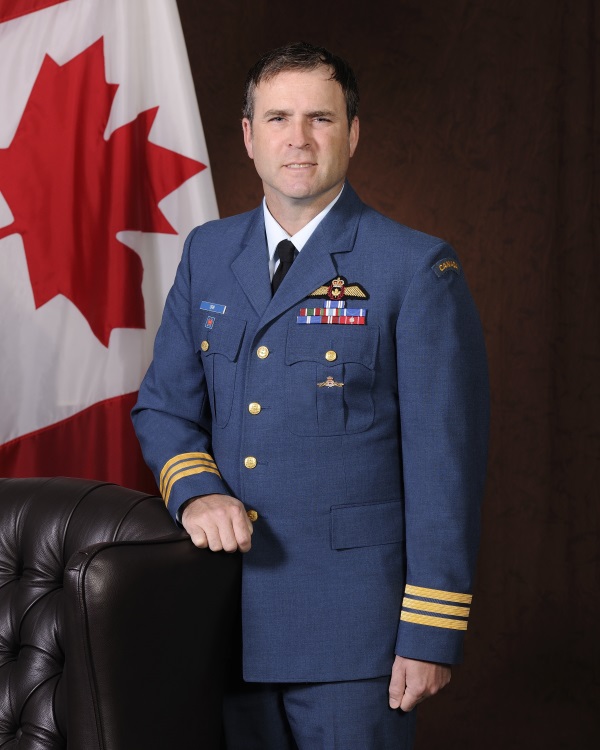
Pour la version français, cliquez ici
Although born in Flin Flon, MB, LCol Orr spent most of his formative years in Tsawwassen, BC, a small town just south of Vancouver. Looking towards a full-time career in the military upon graduating from high school, he enrolled in the CAF in October 1987 as a Reservist and was assigned to the 12th Service Battalion (Vancouver).
LCol Orr continued serving with this unit while simultaneously pursuing civilian flying and undergraduate studies until June 1994. A love for diving saw a service transfer to the Naval Reserve as a Port Inspection Diver at HMCS Discovery, a stone Frigate in Vancouver. LCol Orr remained a diver until May 1997, serving at Discovery and Fleet Diving Units (Pacific and Atlantic) primarily as a full-time NCM.
Upon completion of this chapter of his military career, LCol Orr transferred to the regular force and initiated training as a CAF pilot. Since receiving his commission, he has completed Language (St Jean) and Pilot training (Portage la Prairie, Moose Jaw and Gagetown), long stints attached posted for on job training at both 410 Squadron Cold Lake, and 442 Squadron in Comox.
In August of 2000, LCol Orr arrived in Petawawa, ON to begin his career as a helicopter pilot at 427 Sqn. Since this time, LCol Orr has been on three operational flying tours and two tours as a Staff Officer.
His first flying tour was as a Tactical Helicopter pilot, which included various operations and exercises as well as service in the Balkans where he flew a wide range of flying missions including those in the pursuit of “Persons Indicted for War Crimesâ€.
During his second flying tour he served in a Special Operations Aviation Flight at 427 Sqn as the Deputy Operations Officer, Operations Officer and Deputy Commanding Officer, participating in various exercises and operations throughout North America.
Promoted to Major and posted to Ottawa where he completed a staff tour at National Defence Headquarters (NDHQ) in Ottawa as the Deputy J3 Operations for Canadian Special Operations Forces Command. During this period of time he was confronted with a wide array of challenges in both the strategic and operation environment, working closely with CEFCOM, CanadaCom, the RCMP, CSIS, DFAIT and other Allied SOF units.
LCol Orr’s third flying tour was spent commanding a Special Operations Aviation Flight at 427 including a portion of this tour as the Commander of the First Canadian Special Operations Aviation Detachment in Afghanistan. This detachment was the first occasion that there were Canadian fixed and rotary wing flights, formed an integral SOF aviation element as part of a Special Operations Task Force.
He recently completed a second staff tour in Ottawa as an analyst within Chief of Force Development (DGCSI), where he was confronted with an uniquely strategic environment within NDHQ.
LCol Orr has more than 3000 flying hrs and holds a Bachelor of Business Administration (Finance), degree from Simon Fraser University, and a Masters in Defence Studies from Royal Military College of Canada. He has been with his wife Diane for 23 years and they are the proud parents of two boys, Dylan, 11 and Riley, 8.
Colonel (R) Walter Pirie CD SSM - 427 Squadron 1961-1963
Canadian Air Force Service - 1959-1997
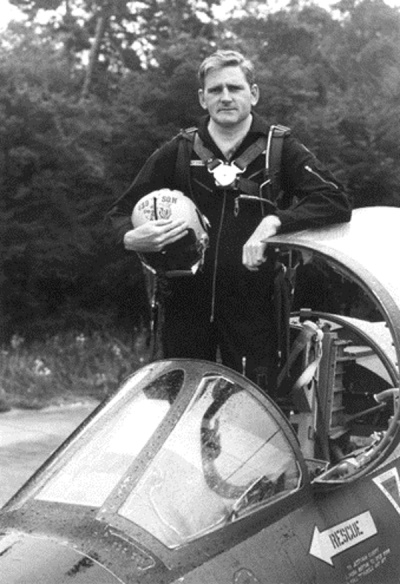
EARLY YEARS
- - Born Halifax, NS 1941
- - Graduated High School - Halifax 1959
MILITARY YEARS
- - Joined RCAF October 1959
- - Completed pilot training 1961
- - Flew F86 Sabre 427 Sqn, Zweibrüken, Germany 1961 - 1963
- - Flew F86 Sabre 441 Sqn, Marville France Jan to Sep 1963
- - Chipmunk & Expeditor Instructor, Centralia, Ontario & Portage La prairie,Manitoba 1963 - 1969
- - Canadian Forces Recruiting Officer, Halifax NS 1969 - 1972
- - Flew CF104 Starfighter, Baden Soellingen, Germany 1973 - 1975
- - Staff Officer, 1 CAG Headquarters, Lahr, Germany 1975 - 1977 (Member of Canada's winning team flying the CF104 as part of 4ATAF's team at the 1976 Allied Tactical Air Meet
- - CF104 Instructor, 417 Sqn, Cold Lake, Alberta 1977 - 1980
- - Canadian Forces Staff College, Toronto, ON 1980 - 1981
- - Deputy Wing Operations Officer & Wing Flight Safety Officer, Baden Soellingen, Germany (Continued to fly CF104) 1981 - 1986
- - Staff Officer, 4th Allied Tactical Air Force headquarters, Heidelburg, Germany 1986
- - Staff Officer, National Defence Headquarters, Ottawa, ON, as Head of the Canada / United States Section of the Directorate of Military Plans Coordination 1986 - 1989
- - French Language Training, Ottawa, ON 1989 -1990
- - Career Manager for Lieutenant Colonel Pilots, Navigators, Air Traffic Controllers, Air Weapons Controllers & Aerospace Engineers. National Defence Headquarters, Ottawa, ON, 1990 - 1993
- - Transferred to the Air Force Primary Reserves 1993
- - Served as Air Command's Deputy Chief of Staff Personnel Liaison located at National Defence Headquarters, Ottawa, ON 1993 -1996
- - Served as Air Command's Director of Personnel during the transition of the Air Command move from Winnipeg, MB to Ottawa 1996 - 1997
- - Retired from the Canadian Air Force with 38 years of service November 1997
- - Completed pilot training 1961
CIVILIAN EMPLOYMENT
- - Contracted by the Canadian Air force to serve as the Air Force representative to the Canadian Forces Y2K Operational Readiness Program as the Canadian lead for Canada / United States bilateral readiness 1998 - 2000
- - Contracted by the Canadian Air Force to serve as Special Advisor to the Chief of the Air Staff / Commander of AIR Command 2001 - 2004 (Responsible, among other things, for the coordination of the Air Force Honourary Colonel Program)
ASSOCIATIONS
- - Chairman of the Sabre Pilots Association of the Air Division Squadrons (SPAADS) 2009 - present
- - Member of the Executive of the 427 Squadron Association 2013 - present
Captain Kathryn Poudrier
427 Special Operations Squadron - 2021 -
Capt Poudrier initially joined the CAF as a Reserve Force Armoured Crewman and continued to work in
the Reserves in Edmonton while in University. In 2002, she left the military to start raising a family with
her husband and finish her first degree in English.
In 2006, she rejoined the RCAF as a Regular Force Imagery Technician and worked at Aerospace
Engineering Test Establishment (AETE) in Cold Lake, Alberta until 2013. She left the military in 2013 to
complete an after degree in Education at the University of Calgary.
In 2015, she rejoined the RCAF at AETE as an Imagery Technician until 2017 when she was accepted as
an Intelligence Officer and gained her commission through the Special Commissioning Plan (SCP).
Captain Poudrier responded to a recent call for volunteers to assist with Association activities. Since our rotary wing website history is limited she has also volunteered to provide a history of 427 SOAS Helicopter Operations covering the CH-135, CH-136 and CH-146 history in the RCAF and 427 SOAS.
Squadron Chief Warrant Officer
427 Special Operations Squadron - 2019-2021
SCWO T.E.F. Riutta
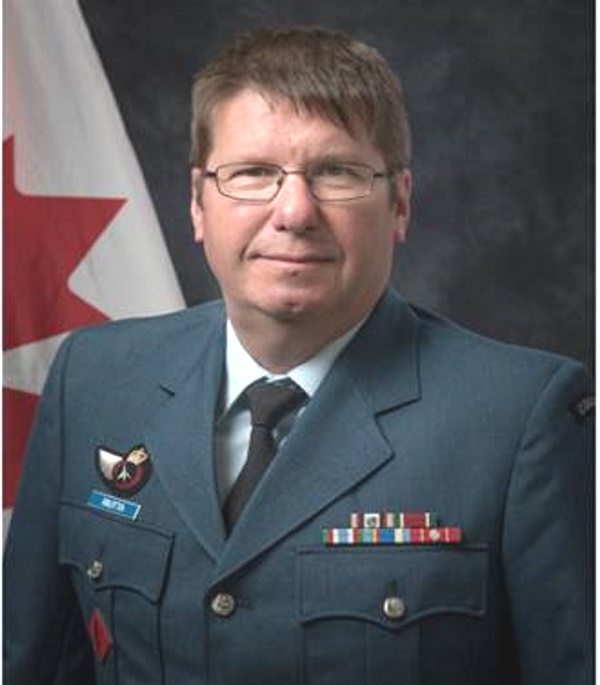
Chief Warrant Officer (CWO) Timothy Riutta was born in Halifax N.S. into a military family. Following in his father’s footsteps, he enrolled in the Canadian Armed Forces on 29 September 1986 and shortly thereafter began basic training at Canadian Forces Base (CFB) Cornwallis. After graduating basic he was sent to CFB Kingston and eventually to CFB Borden to become an Instrument Electrical Technician (IET).
In March 1988, CWO Riutta was posted to CFB Summerside, working on the CH113 Labrador and CC115 Buffalo at 413 Sqn. CWO Riutta followed the Squadron (Sqn) to CFB Greenwood in 1991, working on the CC130 Hercules. In 2000 he was promoted to MCpl and sent to 14 Air Movements Sqn to work on the CP140 Aurora, deploying to Op APOLLO (Afghanistan) in 2003 as the AVN Propulsion Lead.
July 2003 found CWO Riutta posted back to the CC130 fleet, this time at 8 Aviation Maintenance Squadron (AMS) Trenton. Trenton offered many deployment opportunities. The first was BOXTOP (CFB Alert) in September 2003 and then back to the Middle East in December 2003 for two rotations on Op ATHENA (Afghanistan) as the AVN Propulsion Lead. Promoted to Sergeant in May 2006, he became the 8 AMS Training Cell Supervisor, until his posting to the year long French course in August 2009, receiving a promotion to Warrant Officer in December 2009, with posting to 426 Sqn as the Chief AVN instructor for the CC130 fleet.
Posted to Ottawa in July 2012 as a LCMM for the CC115 Buffalo Propulsion Systems. Then promoted to MWO in July 2013, he accepted a posting to the Strategic Joint Staff as Staff Officer in July 2014.
Promoted in May 2017 to his current rank, CWO Riutta was posted to 450 Tactical Helicopter Squadron as the Squadron CWO. CWO Riutta completed 2 years at 450 Tactical Helicopter Squadron (THS) including a 6 month tour to Mali as the AVN Battalion CWO for OP PRESENCE. In June of 2019 CWO Riutta assumed the SCWO role at 427 SOAS.
CWO Riutta is married to his amazing wife Celine, and between them they have 3 children.
Commanding Officer, 427 Squadron, 1992 - 1994
Lieutenant-Colonel Ken Sorfleet
Canadian Air Force 22 AUG 69 to 7 SEP 07
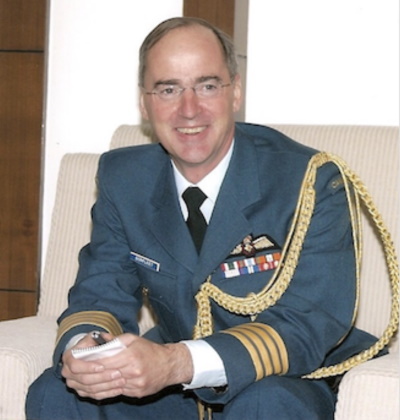
Col Ken Sorfleet was born into a military family on 7 Mar 51 in Saskatoon, Sask. No doubt his interest in flying initially arose in part from his father, who was a CF-100 pilot throughout Ken’s childhood and teen years. Ken’s interest flourished throughout his teens in parallel with his involvement in Air Cadets both in Quebec and BC, but primarily during his latter years with 135 Challenger Squadron in Vancouver where he eventually became the WO1. In addition to Air Cadet summer camp, Senior Leaders, and International Exchange to Germany, Ken received his Private Pilots License (powered) in 1967 via an Air Cadet Scholarship.
In Jun 68, Ken graduated from Kitsilano High School in Vancouver as Valedictorian, then spent a year at UBC getting his senior matriculation. He joined the military in Aug 69 under the Regular Officer Training Programme and spent two years at Royal Roads Military College in Victoria BC, followed by two years at the Royal Military College in Kingston, On. He graduated top of his class in the Engineering and Management Department, was awarded his Bachelor of Engineering Degree, and commissioned as a Lieutenant in May 1973.
He continued on with his flying training on Tutors at CFB Moose Jaw and on CF-5s in Cold Lake and was awarded his wings in Nov 1974 (presented by his father…a nice touch)
He was selected for subsequent training on helicopters which included time at CFB Portage La Prairie and Gagetown on respectively the Jet Ranger and Twin Huey. He was posted to 408 Squadron in Edmonton in Apr 75 and was employed primarily as a Twin Huey pilot for the next three years. He received his promotion to Captain in May 76. In the spring of 78 he completed tactical helicopter training on the Kiowa leading to his posting in July to 444 Sqn in Germany where he was employed as a pilot, section lead, training officer and adjutant from 78 to 81. He completed the CF Staff School training with distinction during this tour, and was posted to the Special Service Force Headquarters in Petawawa as the G3 Aviation and Base Flight Safety Officer, and regularly flew the Kiowa with 427 Squadron from 81 to 83. At the start of this tour he completed the CF Land Force Command and Staff Course.
He was promoted to Major in Jan 83 and posted in Jul to the Directorate of Land Aviation in National Defence Headquarters where he initially worked on the long-term replacement for the Kiowa and Twin Huey fleets which evolved into him heading the Operational Requirements Section for the CF Light Observation Helicopter Project. In Nov 1985, he was selected to attend the Royal Australian Air Force Staff College in Canberra, Aust and after completing this year-long course, he was posted back to 408 Squadron as the Twin Huey Flight Commander. During his time at 408 he was attach-posted for six months in 88 as the Huey Flight Commander for the Canadian Contingent of the Multi-national Force and Observers in the Sinai, Egypt.
` Promoted to Lieutenant Colonel, in Jan 89, he was posted as the Chief of Staff for Northern Region Headquarters, in Yellowknife, NWT, and, in addition to his staff duties, he flew as a Twin Otter pilot with 440 Sqn Detachment in Yellowknife. In Jul 91, he was posted to CFB Winnipeg where he underwent the year long French Language Course.
This was cut short in order for LCol Sorfleet to take command of 427 Squadron while the squadron was deployed at CFB Wainwright on 8 May 92. He remained in command of the squadron until 23 Jun 94. During this time the squadron converted from a combined Kiowa and Huey squadron to a Twin Huey Squadron of 12 helicopters. As well, he was attach-posted for a six-week period to 93 Rotary Aviation Unit in Belet Uen, Somalia to oversee the establishment and initial running of this Operation Deliverance detachment of six 427 helicopters, supported primarily by personnel from his squadron.
LCol Sorfleet was subsequently posted to the Canadian Forces Command and Staff College for a three-year period where he was employed successively as a member of the Directing Staff, the Deputy Director of the Joint and Combined Programme, and finally the Deputy Director of the Air Force Programme. In the summer of 97, he was selected to take up an exchange position as a member of the Directing Staff for the United Kingdom’s inaugural Joint Services Command and Staff Course in Bracknell, UK (amalgamating the year-long single-service run courses at Greenwich, Camberley, and Bracknell).
Ken was promoted to Colonel in Aug 98 and was posted from Bracknell, UK to the Canadian High Commission in London, UK, where for the next three years, he was the Air Force Advisor in the Canadian Defence Liaison Staff, responsible for liaison on all RAF/CF items of mutual interest and for the more than 30 CF air force exchange officers in the UK. As well, during his time in Bracknell and London, Col Sorfleet completed all the relevant studies/courses leading to him being awarded a Master of Arts degree in War Studies from King’s College, London.
In Aug 01, he was posted for a one-year period from London to El Gorah, Egypt - once again to the Multi-national Force and Observers, but this time as the Canadian Contingent Commander, and as the MFO’s Chief of Liaison among this peacekeeping organization and the militaries of Egypt and Israel.
In Jul 02, Col Sorfleet was posted back to Ottawa in order to undertake two years of Mandarin language and other training to prepare him for his final career assignment as the Canadian Forces Attache to the Peoples’ Republic of China. He was based there from Aug 04 to Aug 07, and travelled extensively throughout China, and, as he was also accredited as Canada’s Defence Attache to Mongolia, he regularly travelled there as well. He returned to Canada, in Aug of 07 and took his release from the CF on 7 Sep 07 in Ottawa, culminating over 38 years of service including over 12 years out of Canada – there’s no life like it!
Col (retd) Sorfleet was married to Rosemary (nee Halsall) in Apr of 74, and she has accompanied him on all postings with the exception of the initial six-month posting to the MFO and the short, attached posting to Somalia…she is most deserving of a CD2+. Since retiring in 2007, they both have been based in Ottawa with a second home just north of Ottawa within 5 min of a ski hill. They have two sons, who like them, are happily ‘married’ with families of their own including Christopher (b 77) with two girls in Ottawa, and son Patrick (b80), with one daughter in Fernie BC. Ken continues to be a long-time member of the Legion (Billy Bishop Br 176 Vancouver), the Air Force Association, and 427 Squadron Association. He continues to enjoy skiing, where he is both an On-Snow Instructor and throughout the year a First Aid Instructor with the Canadian Ski Patrol in the Gatineau Zone. Year-round he enjoys casual bridge, and, in the summer, gardening and the occasional walk around a golf course.
As final notes, Ken states that “whatever successes I have had, I give much credit to the Air Cadets of Canada for giving me such a solid foundation in my early years. As well, particularly in regards to 427 Squadron, not only was I fortunate to be able to fly with them as a Capt and Maj, but I was very privileged to return as CO of 427 Squadron, and, I was particularly proud to lead the squadron in our celebrations associated with the 50th year ‘Gathering of the Lions’ reunion weekend in 92, and to be joined in that celebration by two of the finest officers I have known…HCol McNaughton, CO 73-74 and Commander Air Commander 85-86 and at the time our HLCol Dudley Burnside (Gp Capt RAF(Ret)) and first 427 CO (42 to 43) – both truly exemplary gentlemen.”
Commanding Officer, 427 Special Operations Squadron, 2008-2010
Lieutenant-Colonel Kevin G.Whale CD
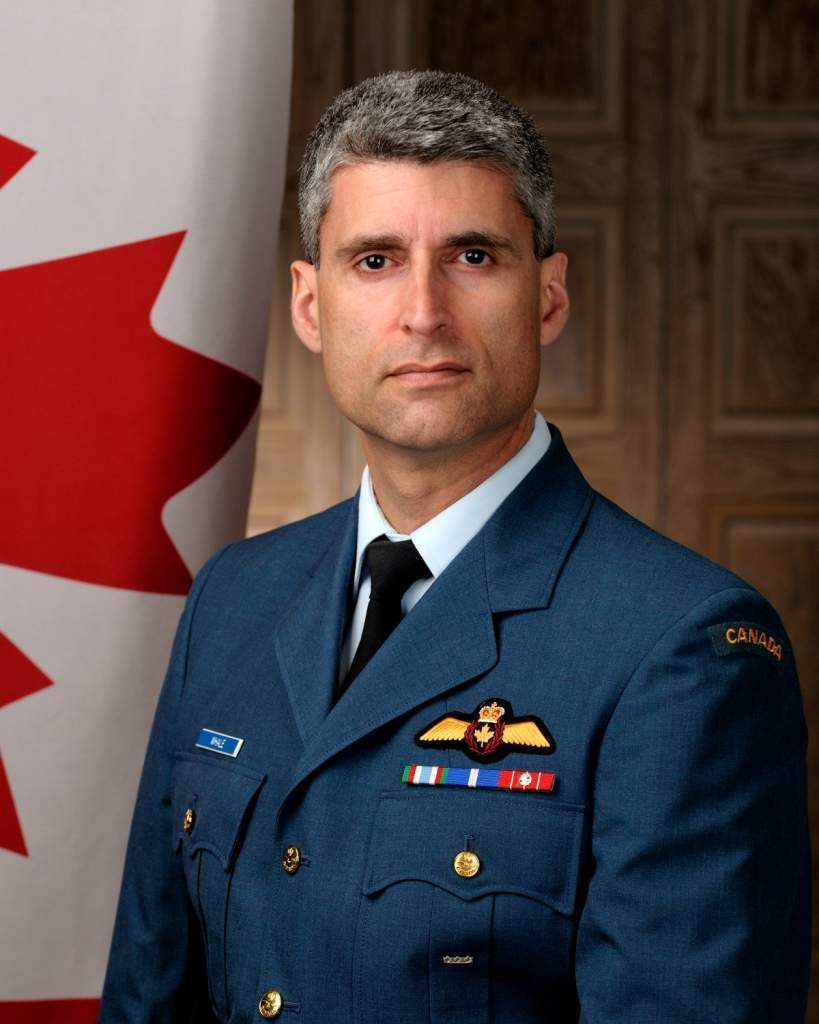
Lieutenant-Colonel Kevin Whale was born in Wallaceburg, Ontario in 1966. He enrolled in the Canadian Forces in 1986 under the Regular Officer Training Plan at the University of Western Ontario, where he graduated with a B.Sc. in Physics in 1988.
LCol Whale obtained his pilot’s wings in 1990 and was posted to 427 Tactical Helicopter Squadron in Petawawa, Ontario, where he flew both the CH136 Kiowa and the CH135 Twin Huey helicopters in reconnaissance and utility roles, including a brief assignment with 444 Tactical Helicopter Squadron in Germany. In 1995 he was selected for an exchange with 1-4th Attack Aviation Regiment, III US Corps, Fort Hood, Texas, flying the AH-64 Apache attack helicopter. As an Attack Platoon Leader, he completed two rotations at the US National Training Center, Fort Irwin, California. LCol. Whale was awarded the US Army Commendation Medal for his contribution to his unit as part of the US Army Task Force XXI program.
Returning to Canada in 1998, LCol Whale was posted to 1 Wing Headquarters in Kingston, Ontario, working initially in the A3 Training section preparing detachments and units for deployments to Bosnia and Kosovo, and then in the A7 section as the Concept Development Officer focused on reconnaissance and firepower enhancements for the CH-146 Griffon helicopter. After completing the Land Forces Transition Command and Staff Course in Kingston, LCol Whale was posted to 400 Tactical Helicopter Squadron in Borden, Ontario, as the Deputy Commanding Officer which included a deployment on Operation Palladium in Bosnia in 2004 flying the Griffon. Following this tour he attended the Canadian Forces Command and Staff College in Toronto.
Since promotion to his current rank in 2005, LCol Whale has held several positions at National Defence Headquarters in Ottawa, including Vision and Strategy Team Leader in The Directorate of Air Strategic Plans, where he spearheaded development of The Air Force Strategy document. In preparation for his return to the Lion Squadron, which became part of Canadian Special Operations Forces Command (CANSOFCOM) in 2006, he completed a brief assignment at CANSOFCOM Headquarters in Ottawa with the Plans and Force Development Staff.
LCol Whale was Commanding Officer of 427 Special Operations Aviation Squadron from August 2008 to August 2010.
Updated Biography for Brigadier General Whale dated April 6, 2020
Thanks to Ken Sorfleet and his Facebook 427 Association page

Brigadier General Kevin G. Whale CD
Originally from Wallaceburg, Ontario, BGen Whale enrolled in the Canadian Forces in 1986 under the Regular Officer Training Plan. Achieving his pilot's wings in 1990, he has completed operational qualifications on Kiowa, Twin Huey, AH-64A/C Apache and Griffon helicopters providing a comprehensive background in tactical aviation mobility, reconnaissance and aerial firepower operations. This was accomplished through tours with 427 Special Operations Aviation Squadron, Petawawa, the 1st Battalion, 4th Aviation Regiment, Fort Hood, Texas, and 400 Tactical Helicopter Squadron, Borden.
His staff experience includes Training and Concept Development at 1 Wing Headquarters, Kingston, Chief of Staff at the Canadian Defence Academy, Kingston and various strategic level positions at National Defence Headquarters in Ottawa including the Canadian Forces Transformation Team, the Directorate of Air Strategic Plans, Acting Director General Air Readiness And Special Advisor to the Minister Of National Defence.
BGen Whale's command and leadership roles have included those of a US Army Aviation Attack Platoon Leader and Aviation Battalion Battle Captain, Squadron Deputy Commanding Officer (400 Tactical Helicopter Squadron, Borden), Squadron Commanding Officer (427 Special Operations Aviation Squadron, Petawawa)and Wing Commander ( 1 Wing, Kingston).
His international experience includes an assignment with 444 Tactical Helicopter Squadron, Germany, an exchange posting with the US Army,1st Battalion/4th Aviation Regiment, Fort Hood, Texas, a flying tour on OP PALLADIUM in Bosnia, integration of Special Operations Aviation Detachments in Afganistan and as Chief of Current Operations on OP MOBILE (Libya) in NATO's Combined Joint Task Force Headquarters, Naples, Italy.
His professional development and education include a B.Sc. in Physics fron the University of Western Ontario, a M.Sc. in Organizational Leadership from Norwich University, Vermont, the Land Forces Transition Command and Staff Course, Kingston, the Joint Command and Staff Program and the National Security Program at the Canadian Forces College, Toronto.
BGen Whale's recognized achievements include a US Army Commendation for his contribution to the US Army Task Force XXI program, a Commander 1 Canadian Air Division Commendation for aviation project development, a Chief of the Air Staff Commendation for Air Force strategy development and two Chief of Defence Staff Commendations for his service during OP MOBILE and for contributions to RCAF readiness.
Just in April, 2020 - Brigadier-General Kevin Whale, currently the Director General and Component Commander-Space will be posted to Colorado Springs as the first Canadian in the post of Deputy Commander Plans in the USAF Space Command.
Flight Lieutenant Arthur W. "Sask" Wilford SSM ON
427 Squadron 1957-1960
Royal Canadian Air Force Service - 1955-1965
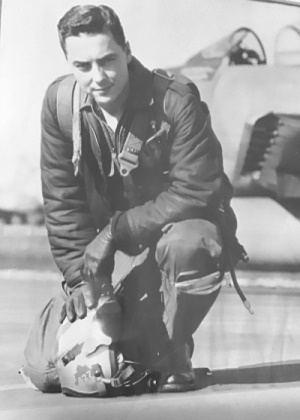
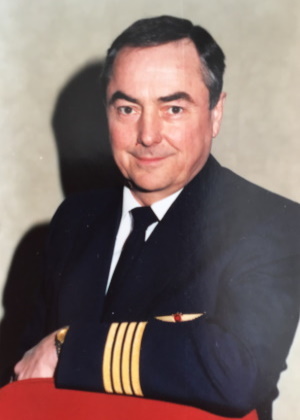
A toothy and smiling Jack-O-Lantern welcomed this aspiring young aviator into the world on Oct. 31, 1937. Born into a military environment (father was a veteran of both world wars and served at Vimy Ridge), it was no wonder Sask chose the same path. When he left North Battleford Collegiate in 1955, he was a veteran Air Cadet and proceeded directly to Queens University under the ROTP. Engineering was OK but all he wanted to do was fly airplanes, so he transferred into the regular Air Force in January 1956 (course 5601). The next ten years are "dot pointed" below.
- 1956-57 - Selected for pilot training - Chipmunks, Harvards and T-33s. Posted to OTU on the F-86.
- 1957 - Posted to 427 (F) Squadron, Zweibrücken, Germany. 20th Birthday on the boat going over.
- 1957-60. A highlight was "phase training" new Squadron(Sqdn)pilots. (Wayne was one) Departed 427 Sqdn. as Flight Commander. "C" Flt and Squadron Fighter Weapons Instructor. Celebrated 23rd Birthday on the boat going home to a flight training posting at Penhold, Alta.
- 1960-64. Instructed basic flying skills to RCAF and NATO ab initio pilots. Departed Penhold in the fall of '64 having served as Flight Instructor, Standards Pilot, Flight Commander and acting Chief Standards Officer. Awarded the coveted, A-1 Flight Instructor Category. Posted to Chatham, NB to instruct at the Sabre Transition Unit (STU).
- The STU instructor role was teaching low level, high speed navigation techniques and related weapon delivery to the pilots transitioning to the CF-104. What a perfect fit for a "Fighter Pilot" mentality, the future looked very bright, however these were difficult times for Short Service Commission(SSC) pilots.
The lure of commercial aviation was strong and the prospects for a permanent commission seemed "iffy" after ten years, so when his application with Air Canada was accepted his decision was obvious.
Air Canada 1965-1999
Commercial Aviation
The transition to airline flying presented a whole new set of challenges to his enshrined "Fighter Pilot" mentality. A good Airline Captain not only flew the a/c to a very high standard but was required to be the "Team Leader", co-ordinating the efforts of System Operations Control, Flight Dispatch, Crew Manning & Scheduling, In-Flight Service, Line Maintenance, Ground Handling, On-Board Crew Co-ordination and all of this focusing on "customer service" (not fighter pilot ego). Sask welcomed these new challenges and after serving 13 years as First Officer and Line Captain, he was invited to join the Flight Operations Management team. He served in this capacity for the remaining 19 years of his 32 plus year career.
His operational Supervisory Roles included Flight Instructor, Manager Flight Training, Transport Canada Designated Check Pilot, Chief Pilot DC-9, B-727, B-767.
After completing the Executive Program at Queens University he served in the following Headquarter staff positions.
Acting Director Flight Training, Manager Flight Operations and Director System Flying Operations providing direction and oversight to all Chief Pilots on all equipment at the four pilot bases Montreal, Toronto, Winnipeg and Vancouver .
Secondary Duties
- Company negotiator for two successive Pilot Contract negotiations with the pilots' union (ACPA/CALPA).
- Assigned as Personal Pilot for the State Visits of Cory Aquino, then President of the Philippines and later on, for the Princess of Thailand.
- Assigned as the Captain for the Air Canada sponsored "Dreams Take Flight" program (The transport of underprivileged kids to Disney World in Orlando Florida). He and Captain Wayne did the 1989 privilege flight.
- Assigned as Fight Co-ordinator and Personal Pilot for Prime Minister Mulroney during his two-week cross Canada campaign for re-election in 1988.
- Mayday - He suffered a normally career ending, full heart attack in 1984 while curling with Wayne, in Guelph.
- Blessing - Thanks to advancements in medicine and Transport Canada rule changes, he was one of the first commercial pilots in Canada to ever be relicensed after suffering a full myocardial infarct and was thus able to serve the company for 13 more years in various roles as previously indicated.
- Retirement - When he "aged out" in 1997 (at age 60) he was forced to retire as a pilot, however the V.P (Wayne) rehired him to run the pilot hiring program during a major expansion period for the airline.
In 1999, his 44 year career in aviation ended having flown Chipmunks, Harvards, Expeditors, T-33's, Sabres, Viscounts, Vanguards, DC-9s, DC-8s, L-1011s, B-727s, B-767s and B747-200s. Flying time approximately 18,000 hrs.
Looking back - For the young Air Cadet in 1955, dreaming of becoming a pilot, his four-decade career in aviation has far exceeded his wildest dreams. In summarizing his career thoughts, he is wont to say "It was a privilege to have worked with so many highly skilled professionals. The Canadian military pilots and their counterparts in commercial aviation, are second to non in the world."
COMMUNITY & FAMILY
COMMUNITY
- Active member of the Canadian Legion (50 years), RCMI, and the Airforce Association.
- Charter member of the 427 Squadron Association beginning in 1996 and served on the executive from 2004 to present.
- Awarded the Lionheart Award September 12, 2014.
- Founding member of 242 Ross Ferguson Squadron, Air Cadets. Served 9 years on the sponsoring committee.
- All Saints Church, Erin: Choir member for 50 years, Rector's Warden, Trustee for 18 years and chairman for 5 years, Elected Trustee Emeritus in 2018.
- Active supporter of the Erin Refugee Committee (Syrian and Afghan families rehabilitated to date).
- In 2017, Bishop Michael of Niagara Diocese awarded him the Order of Niagara (ON) for outstanding service to the church and community.
- Mayday: He suffered a second major heart attack in 2005. Open heart surgery followed with bovine aortic valve replacement, mitral valve decalcified remotely then sewed back on, and a double bypass. All was well for 13 years until the bovine aortic valve eventually wore out and he required a second (successful) implant in 2018.
FAMILY
Sask met a beautiful young Canadian nurse who was visiting a former classmate, then married to a Clunk Driver (CF-100) at #3 Wing. After pursuing her for almost a year upon his return to Canada, Kathy finally relented and they were married in 1961. They are now enjoying their 60th year of marital bliss (in lockdown), have raised 3 wonderful and successful offspring (now in their 50s), and are very much in love with their two outstanding grandsons. Life doesn't get any better.
HOBBIES
Sask is a locally acclaimed "master craftsman" woodworker and is also a self-taught motor mechanic, electrician, plumber, carpenter and mason. However, his true love is golf (at least 3 times per week this year).
His 83rd Jack-O-Lantern, carved almost a month ago, didn't have as many teeth as the original but the smile was even bigger.
Sergeant Harry Winter - W/Op - Air
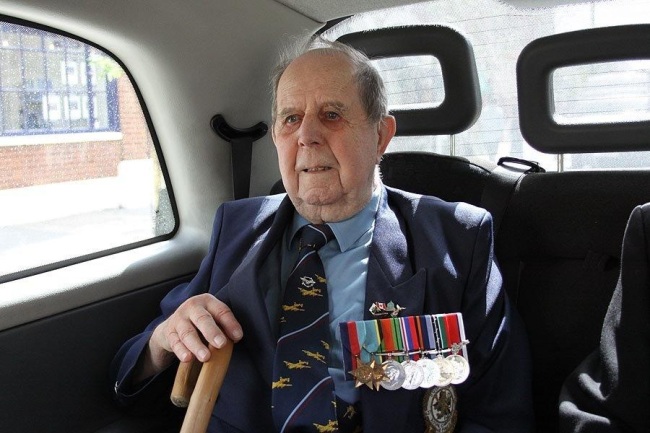
His Biography - In His Own Words
I was born in 1922 in Cardiff and attended school during the years of the depression and high unemployment. My father was a tradesman and was therefore in permament employment as a maintenance engineer.
When I left school I took up employment at the local paper making mill, first as an assistant stock keeper, then in the costing department and then to processing orders for the machines.
In May 1940 there was a call for volunteers for the LDV, called the Home Guard, so I joined the local force doing guard duty at the BBC and the Head Post Office. On January 2, 1941 Cardiff experienced its first blitz and I decided to retaliate and volunteered for aircrew in the RAF. I had my ACSB (aircrew selection board)in May and was called up in September.
After eighteen months training I was passed out as a Sergeant Wireless Operator (Air)and posted to an AFU (advanced flying unit)then to an OTU (operational traing unit)where I crewed up with a Canadian crew and did my first operation in a Wellington bomber. At this time the four engine bombers were replacing the twin engine ones so my crew was sent to a heavy conversion unit where we picked up an additional air gunner and a Flight Engineer as we transitioned to the Halifax bomber. On completion we were posted to another Canadian squadron, 427 Squadron. Our Squadron had been adopted by a major Hollywood film company, MGM, and we were allowed to name our aircraft after the stars. The Squadron then also adopted
a lion cub at London zoo because the opening screen of any MGM movie was a roaring lion. We became known as the Lion Squadron. On my nineteenth operation over Germany , our aircraft was shot down near Hamelin. The pilot was killed and the two gunners, I received wounds in the legs which kept me in hospital for seven months. On my journey from Hamelin to Dulag Luft near Oberursel for interrogation I was confronted by an armed soldier while laying on a stretcher on a train station platform who wanted to shoot me.It was only the intervention of the Feldwebel (Sergeant) escort which saved my life, After hospital trearment I was sent to a prison camp in Upper Silesia(now western Poland) in July 1944. In January 1945 the Russians were making a big push westwards so the Germans decided to evacuate the camp. From January 19, 1945 to February 28 we were on a forced march in sub-zero weather, minus 25C, through Czechoslovakia into eastern Germany, finally ending up south of Berlin where we stayed until overrun by the Russians in April.
We were kept as hostages by the Russians until all Russians in German hands had been returned. I decided to escape and with American assistance crossed the Elbe river, which was the border between the Russians and Americans to Schoenbeck. From there we were trnsported to Hanover, flown to Brussels,taken by train to Lille and the Lancaster to Dunsfold, train to Cosford for a medical then home by May 10, 1945.
I returned to civvy street going back to my old job and after three years was transferred to the paper coating mill where I spent a further six years. In 1955 I moved to London and took up a position as a paper salesman and technician.
I have also been active as a Mason. My Masonic career started in 1960 when I was iniated into the Manor of Bensham Lodge No. 7114 and was installed as Master in 1970. Since then I have been through nine Chairs and I am the founder of the Redhill Mark and RAM lodges. On ret.irement in 1984, I decided to occupy myself as a Tyler which keeps me active during my closing years.
I have been married for sixty eight years, having celebrated my diamond wedding at Oakfield Road in October 2001. We had two sons , one married with a son and daughter. He has recently retired from the Metropolitan Police. The second son is single, a railway driver Instructor who has a model railway in his loft and another larger set in his garden.
I have travelled through every country in Europe except Spain and have traversed Canada from west to east twice.I have travelled every coastal state in America and some inland ones. I have been twice to the Hawaiian Islands visiting four of them including Pearl Harbour.
Masonically I have visited The Grand Lodge in San Francisco and Boston, also a lodge in Hamelin, Germany. I have also had a Concorde flight and a trip on the Orient Express.
That seems to have covered my life so far.
To return to Harry' Story Click Here.